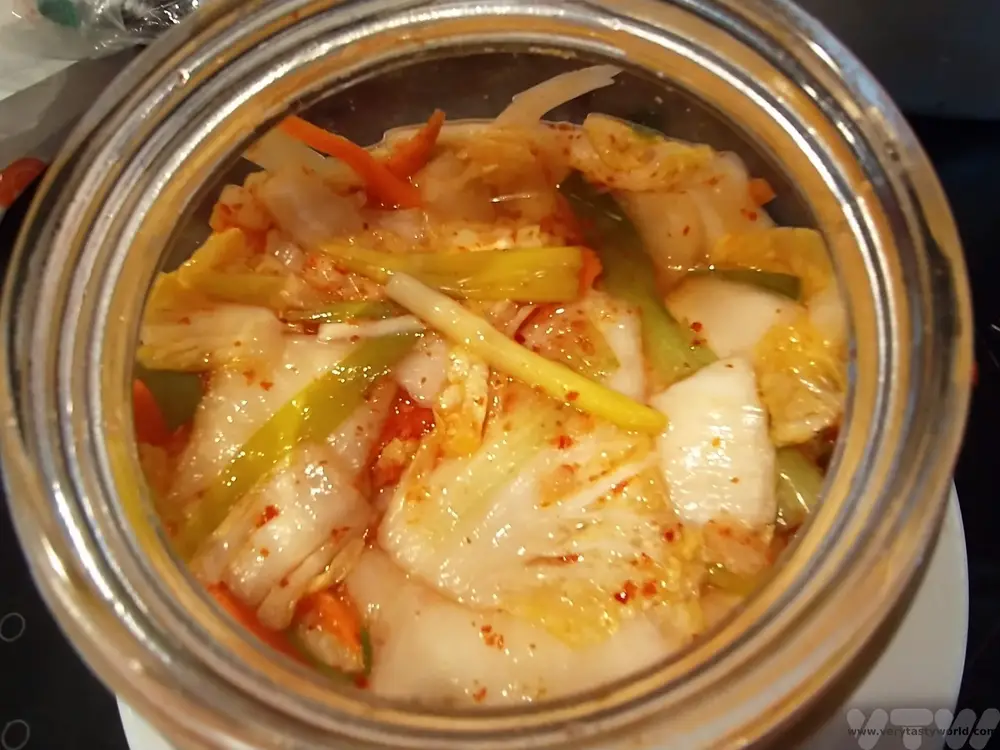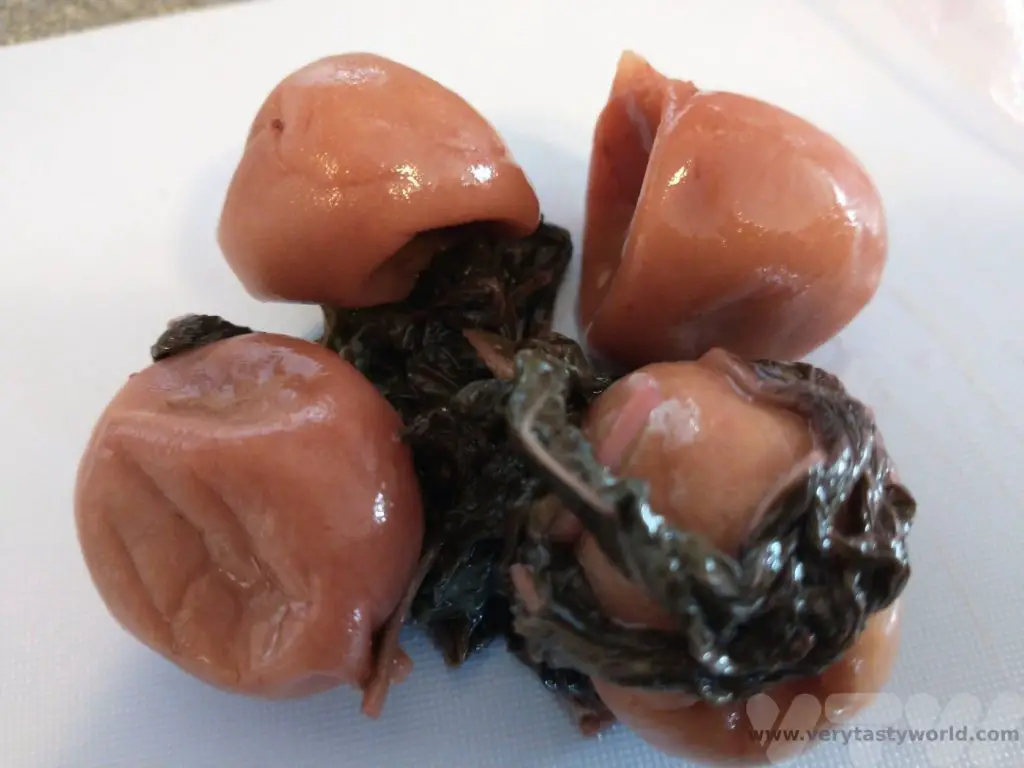Home » Posts tagged 'Korea'
Tag Archives: Korea
A Korean Table Setting – Eating Out in Korea
Korean cuisine is one of the finest in the world. It’s so good that UNESCO have acknowledged it. We have recently returned from a trip to this amazing country. We wanted to try as much local food as possible so ate at a variety of restaurants as well as spent time discovering the vibrant street food scene. Korean people are passionate about their cuisine. We also enjoyed learning about the importance of the Korean table setting. Here’s our guide to dining and etiquette in Korea.
Please note that this post contains affiliate links. If you click through and decide to make a purchase we will earn a small commission, at no extra cost to you, which will help towards the costs of running this site.
Our Korea trip took us to Seoul, Gyeongju, Busan, Daegu and back to Seoul, so we were able to taste dishes from all over the country. We found travelling through Korea to be very straightforward – the public transport system is excellent and very easy to use. You can buy a railcard which gives you access to the extensive rail network that will whiz you all over the country.
Dining was also easy in the main – many restaurants have multi-language menus or ordering systems. Everywhere we went, we discovered that the local people were delighted to help us learn about their delicious cuisine.
Dining Etiquette – The Korean Table Setting
The table setting is significant. Rice should be set to the left and soup to the right. (The other way round represents offerings to the dead.) The rough rule is that cold and/or dry foods are set to the left, and hot and/or wet foods to the right.
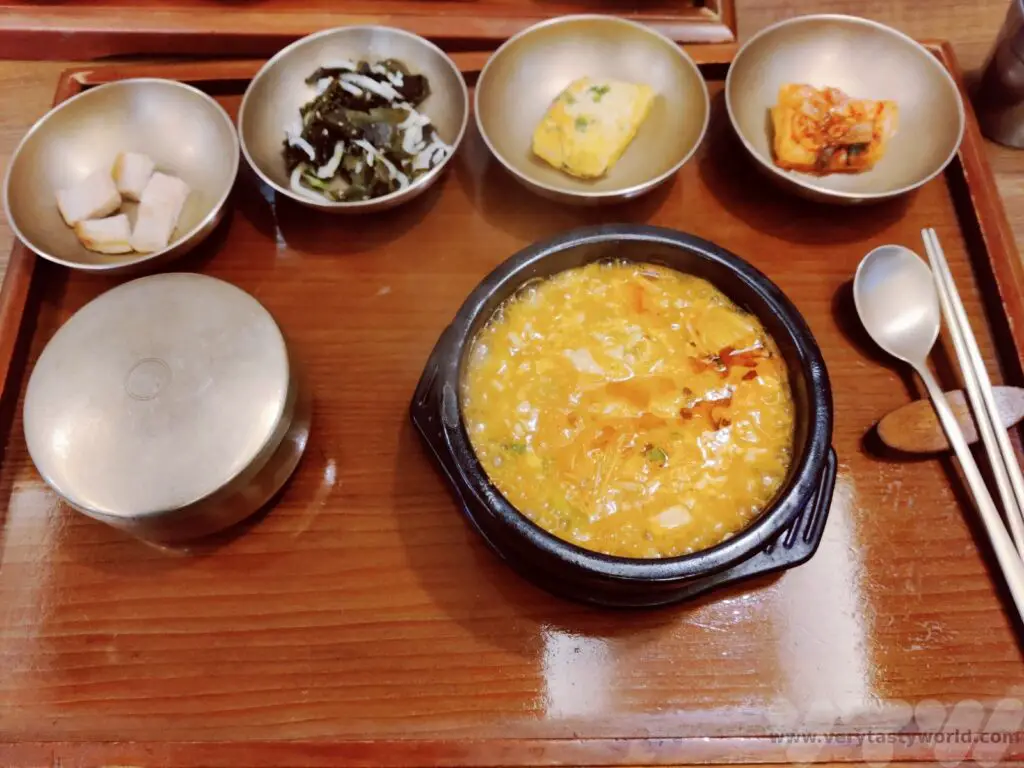
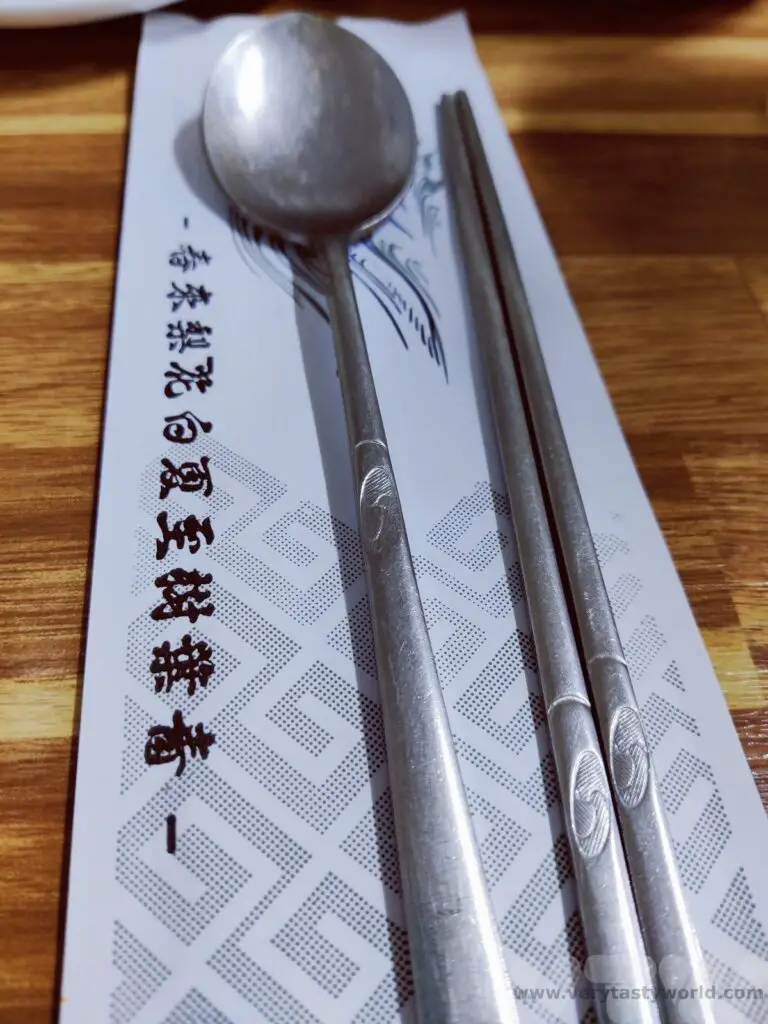
Koreans use chopsticks and a spoon to eat their food. Chopsticks are used to pick up specific items and the spoons used to scoop rice or eat soup.
Chopsticks in other Asian countries are usually made from wood but in Korea chopsticks are metal.
It is polite to use a spoon to drink soup – in fact, unlike many countries in Asia where it is okay to bring the rice or soup bowl to your lips, it is best to keep all bowls on the table. Use the spoon to bring rice or soup to your mouth.
There’s no formal way to eat rice. If served a stew with rice how you eat it depends on personal preference. Some people tip the rice directly into the stew, others scoop a spoonful of rice at a time and dunk it into the stew to pick up some of the flavour. And yet others never mix their rice with sauce and eat it plain.
Using a spoon and chopsticks is an efficient way to eat. In fact, over the course of our trip, we learned to use the spoon with our left hand and hold the chopsticks with our right – maximising eating potential! It’s absolutely fine to swap hands, put down the chopsticks down on the chopstick rest or on top of the bowl and pick up the spoon with the same hand. It’s considered that, as most people are right handed, another reason the soup is set to the right is so that it’s easier to use your right hand with the spoon to avoid spillage.
Don’t stick your chopsticks vertically into your food as that is the way that offerings are made to the deceased at funerals.
If you are eating with a group, the eldest members of the party will eat first.
When it comes to drinks it’s polite to order just a suitable number of bottles of beer, soju (a clear distilled spirit which normally has the strength of fortified wine) or makgeolli (a cloudy rice wine which has a similar ABV to beer) and share rather than order one for each person. You can always order another. You shouldn’t pour your own drink but pour for others using both hands. The recipient should hold the cup or bowl with both hands to receive.
Before starting to eat, say, ‘jalmeokgesseumnida’ which means ‘eat well’. If you get it wrong you won’t be ostracised but the correct etiquette will be appreciated.
One of the most delightful things we found about dining in restaurants was how keen the local people were to show us how to eat the food. For example, if you order bibimbap – mixed delicious things served over rice – you receive a bowl of beauty then dig in with the spoon and mix it all together before scoffing. Even if we couldn’t speak much Korean, the restaurant staff would demonstrate what we should do with each dish. It was very helpful.
Restaurant Dining
Many restaurants offer a self-ordering process where you walk up to a machine and place the order. Pretty much every restaurant we visited that had self-ordering had an English language option, as well as Japanese and Chinese. We found that most restaurants had an English menu which was sometimes quite basic but absolutely fine. Where restaurants didn’t have an English menu, we either guessed (we had learned to read Hangul before travelling so could tell what we were probably eating but didn’t know how it was cooked, but that’s okay as we eat pretty much anything) or we pointed to pictures of the food.
If you have ordered using a machine, order the food and either wait for it to arrive or for the number on your ticket to be called out. Keep an eye out at the serving hatch if you don’t know your number – the staff will most likely know that the food is for you and will beckon you over.
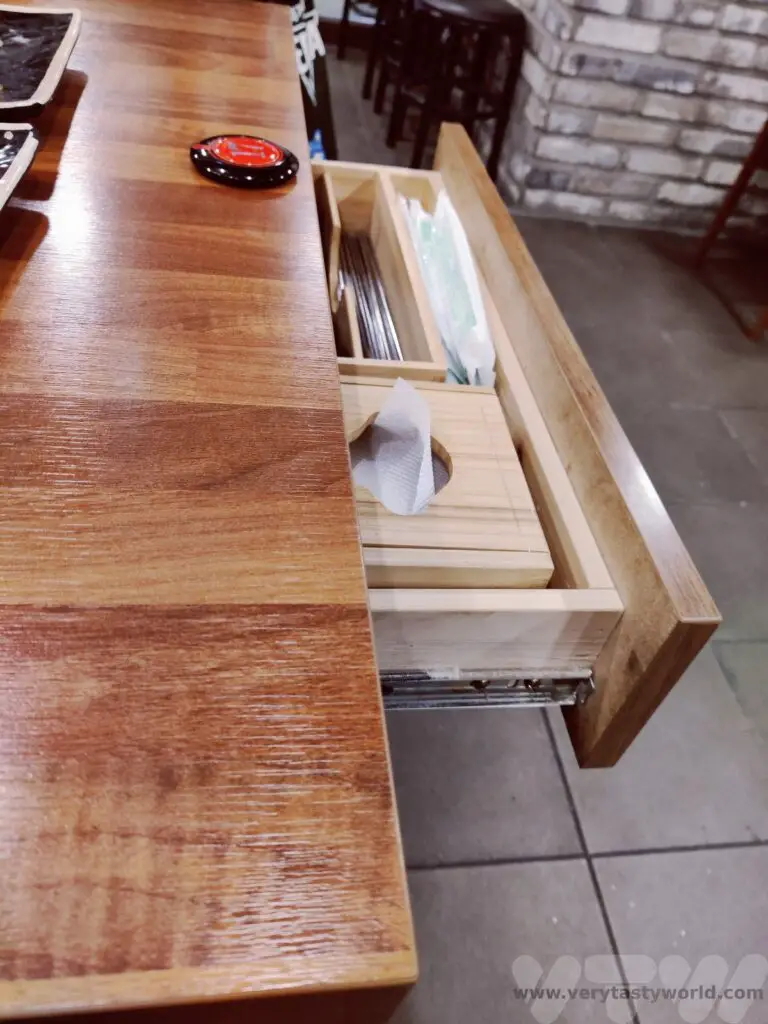
If you can’t find chopsticks and spoons on the table, they will almost certainly be available – either in a box or, rather cleverly, in a drawer under the table. The Golden Rule for a Korean restaurant: always look under the table.
Also, if you want to call over the waiting staff, there is often a button on the table which you can press.
Water is always provided and it’s free of charge. Many restaurants will bring you a bottle or jug of water and some cups but you may have to help yourself. If this is the case there will be a water dispenser and cups available somewhere in the restaurant.
Korean meals always come with banchan – side dishes. Sometimes these will be brought to the table and other times there will be a self-service bar where you can pick up a dish and fill it yourself. Look out for broths as well – there is often soup or broth in a large vat somewhere in the restaurant. It will be a rare meal when you aren’t supplied with kimchi, the ubiquitous and delicious spicy fermented cabbage, which is Korea’s national dish.
At some restaurants the bill was placed on our table when the food was delivered, at others we paid in advance using the machine and yet others the bill was calculated afterwards. You don’t request the bill – just saunter up to the payment area and pay. Cash is fine, cards were accepted in most places. Tipping is not expected nor required. Indeed, like Japan, tipping can sometimes be considered rude.
The Joy of Banchan
One of the most amazing things about Korean dining is banchan – the side dishes. The variety of banchan is quite remarkable. And they aren’t just thrown together. As much care is taken in preparing the banchan as the main dish.
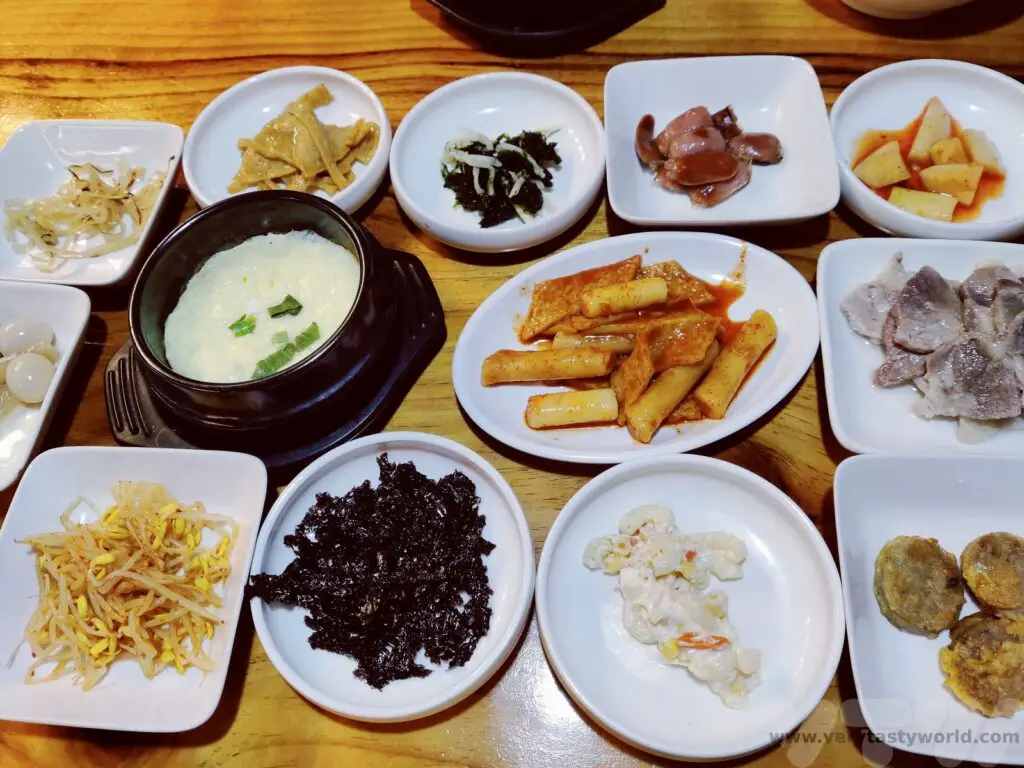
And the very best thing about banchan is that you can order more for free! (It would be a bit rude to ask for more of the dish you have ordered or extra rice, unless you are happy to pay more.)
Of all the banchan, kimchi is the most famous. This crunchy, spicy fermented cabbage dish will be eaten with almost every meal. Even our airline meal to Korea included a packet of kimchi.
It is such a fundamental part of society that it has its own day – 22nd November – and families get together every year to make kimchi. Kimjang: Making and Sharing Kimchi was inscribed on the UNESCO Representative List of the Intangible Cultural Heritage of Humanity.
Korean households usually have two refrigerators – one for normal food and the other, which is set at a specific temperature, for a year’s worth of kimchi! We have been making kimchi for years and have an easy kimchi recipe.
Quintessential Korean Dishes to Try
Bibimbap
This is one of the most well-known of Korean dishes. It is a rice bowl topped with all sorts of delicious ingredients – from vegetables to marinated meat – sometimes garnished with a fried egg. Gochujang, the spicy (not overly spicy) chilli sauce forms the basis for the flavour. Sometimes the bibimbap is presented with the toppings on the rice but in ‘fast food’ bibimbap restaurants the toppings will be placed in the bowl and you will be served the rice separately, to put on top yourself.
The best way to eat bibimbap is to admire it first then get your spoon in and mix it all together, add some sauce, mix some more and then scoff.
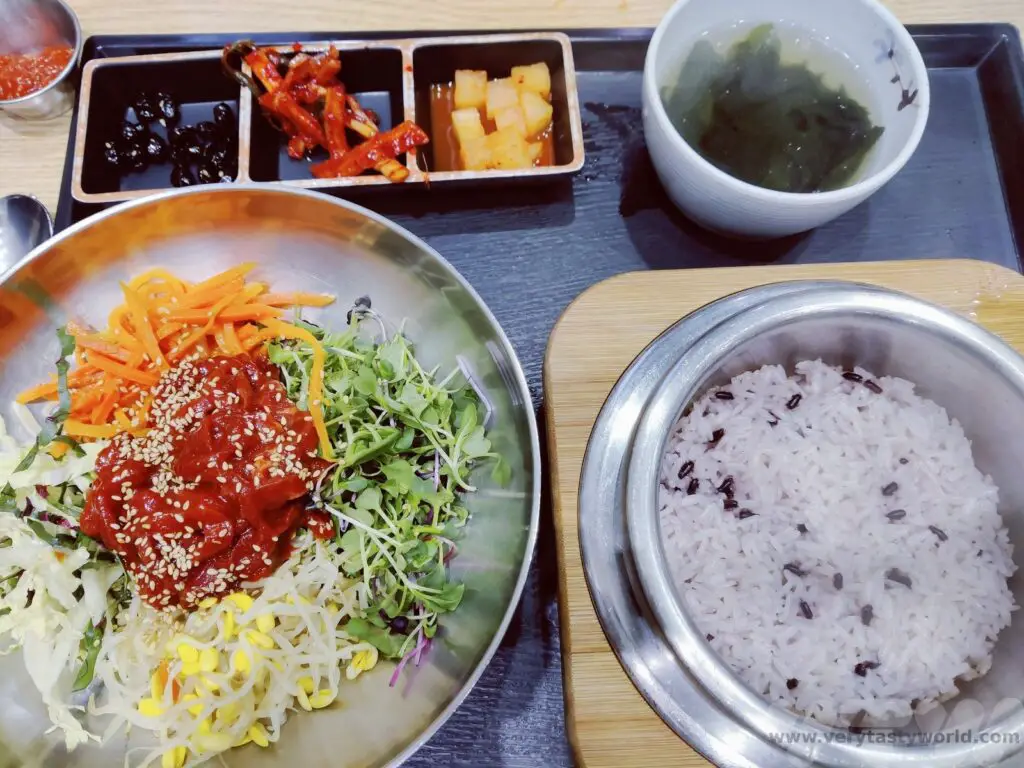
Sharp-eyed readers will notice that in the picture above the rice is served to the right. This is because we were given a tea pot and , after transferring the rice into the bowl of goodies, we then added hot stock to the rice crust inside the bowl to make a lovely soup.
Gimbap
They may look like Japanese sushi maki (sushi rolls) but gimbap (gim = seaweed, bap = rice) are very different. They are not seasoned with vinegar but sesame and they are sauced internally. Whereas maki often largely comprise raw fish, gimbap includes a vast array of ingredients – there is much more filling than rice. You can expect pickles, fresh vegetable, meats/fish or omelette all lovingly wrapped in a seaweed casing. You don’t dip them in soy sauce or wasabi. Many gimbap outlets in the cities are open 24 hours so this makes a great breakfast option.
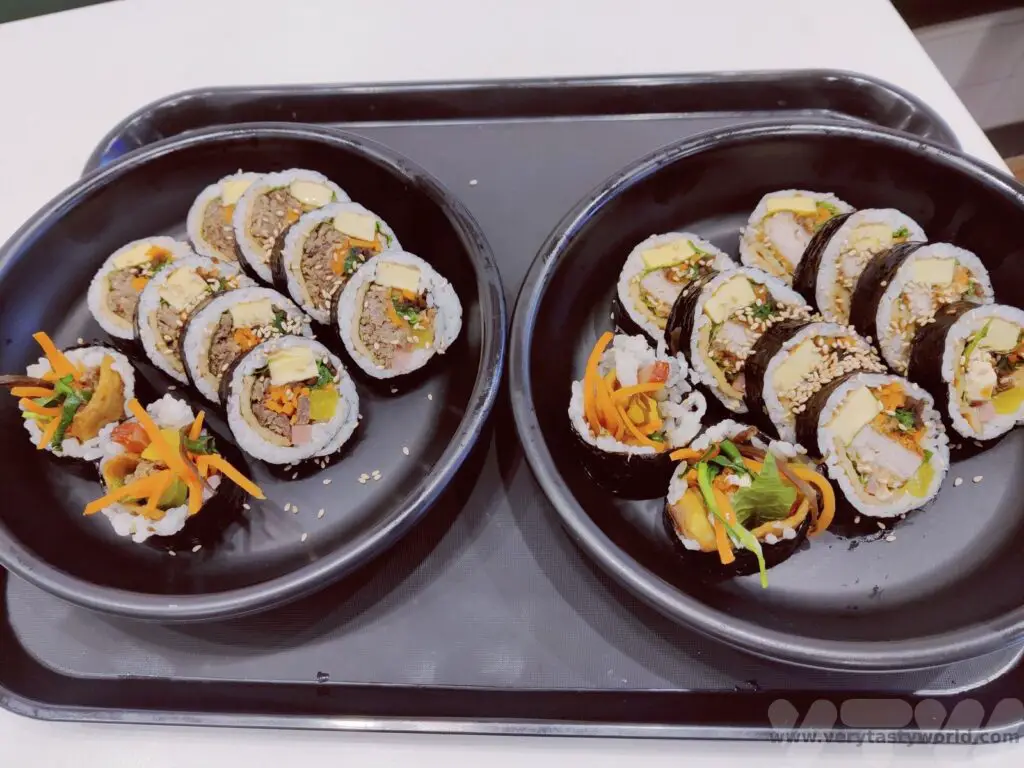
BBQ
Another essential meal to enjoy while visiting Korea is BBQ – luscious cuts of meat, sizzling on a hot plate, cooking over fire (sometimes butane but charcoal is traditional which adds a delightful smoky element).
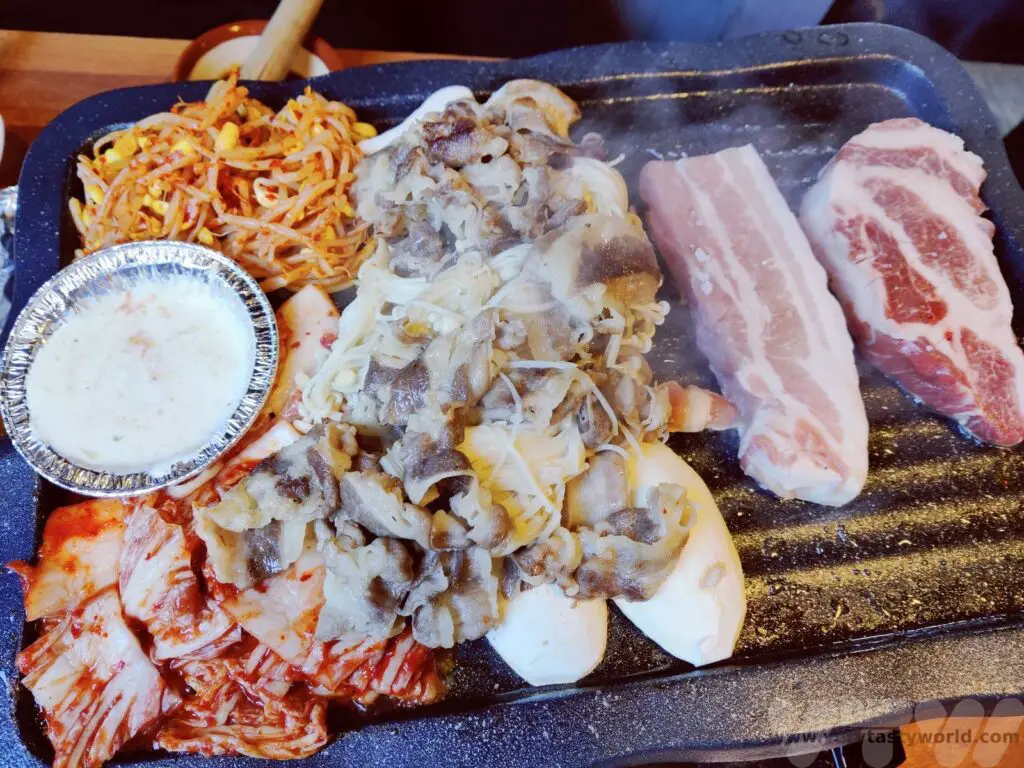
And BBQ is where another brilliant Korean table setting element comes into its own: the scissors! Korean kitchen scissors are the absolute best, they have thicker blades than ordinary scissors and cut food quickly and efficiently.
The meat is initially seared and cooked as a full joint. Then, as it cooks, tongs and scissors are used to cut the meat into bite-sized strips.
If you aren’t confident doing the cooking, the staff are absolute experts and will know exactly what to cook and in what order, so you can sit back, sip a soju and enjoy the show. But if you fancy having a go it’s fine to go for a DIY approach.
Ssam, which means ‘wrapped’, is a great way of enjoying BBQ. As well as banchan, a number of different leafy vegetables will be supplied – lettuce leaves or herbs such as perilla (below). You pick up a juicy piece of bbq meat with your chopsticks, place it on the leaf, add some kimchi and a dab of sauce, then wrap it up and pop it into your mouth – delish! If you run out of leaves, you can always ask for more.
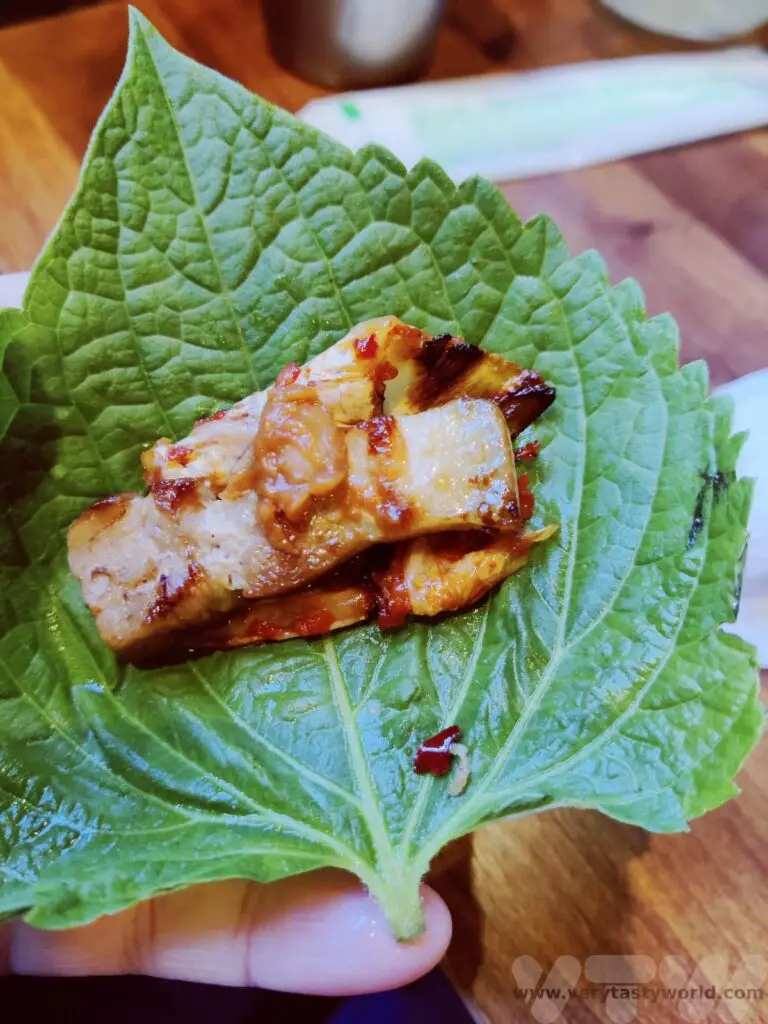
Chimaek (Chicken and Beer)
KFC is an essential item to try when visiting Korea. Not that KFC, of course, but Korean fried chicken. Chimaek 치맥 derives from chikin = fried chicken (unsurprisingly) and maekju = beer.
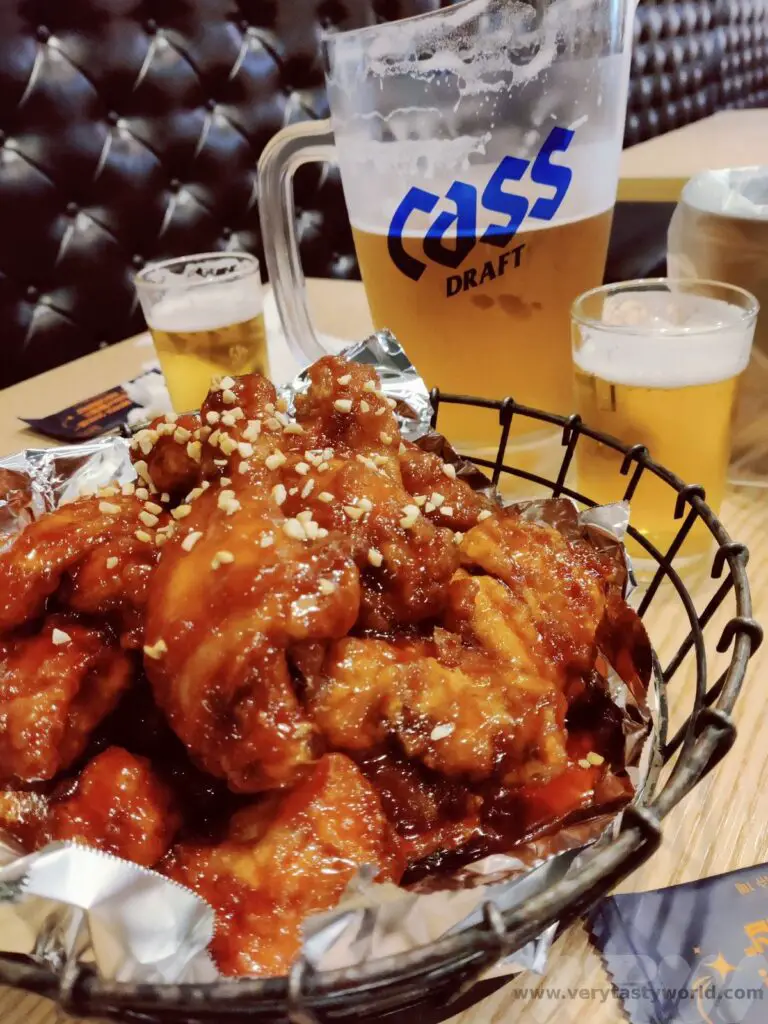
A very sociable way to enjoy fried chicken is to scoff it with beer and enjoy it with friends. When we visited a chicken and beer restaurant in Busan a single order provided a whole chicken’s worth of deep-fried joy, in a spicy sauce. Local beers are much cheaper than imported.
Bulgolgi
Bulgolgi is very popular dish comprised of marinated thinly slices of meat, usually beef, cooked on a griddle. The name translates as fire meat (bul = fire, golgi = meat). Some restaurants will offer a set menu where bulgolgi forms the centrepiece of the dish and you have multiple banchan to accompany, other restaurants let you cook the meat at the table. Just use your chopsticks to pick heavily flavoured, succulent pieces of meat.
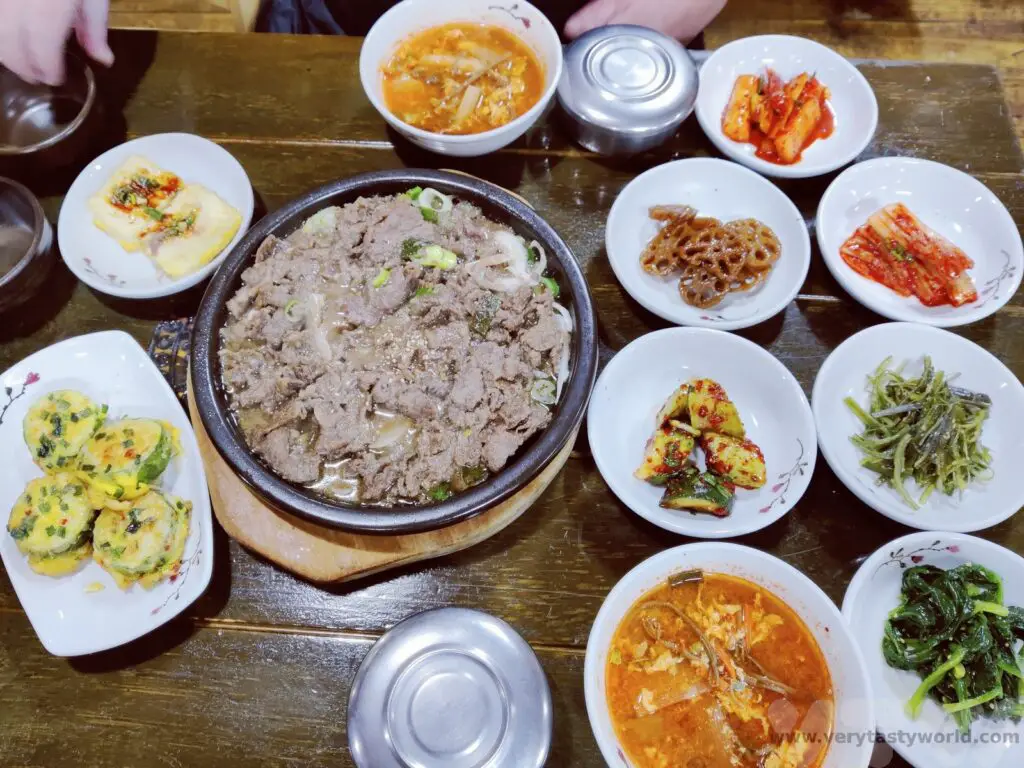
Jjigae (Korean stew)
We visited in November and temperatures were dropping fast as winter approached. Jjigae is comfort food – warming and delicious. There are many varieties available – meat, tofu and vegetables – seasoned with a variety of sauces. Gochujang (chilli paste) and doenjang (soy bean paste, a bit like miso) are popular options. Stews will always be accompanied by rice and banchan. It makes for a feast.

Pajeon (Korean pancakes)
Pajeon is a celebratory food. These are pancakes that incorporate vegetables (largely spring or green onions) and other delectable fillings such as seafood.
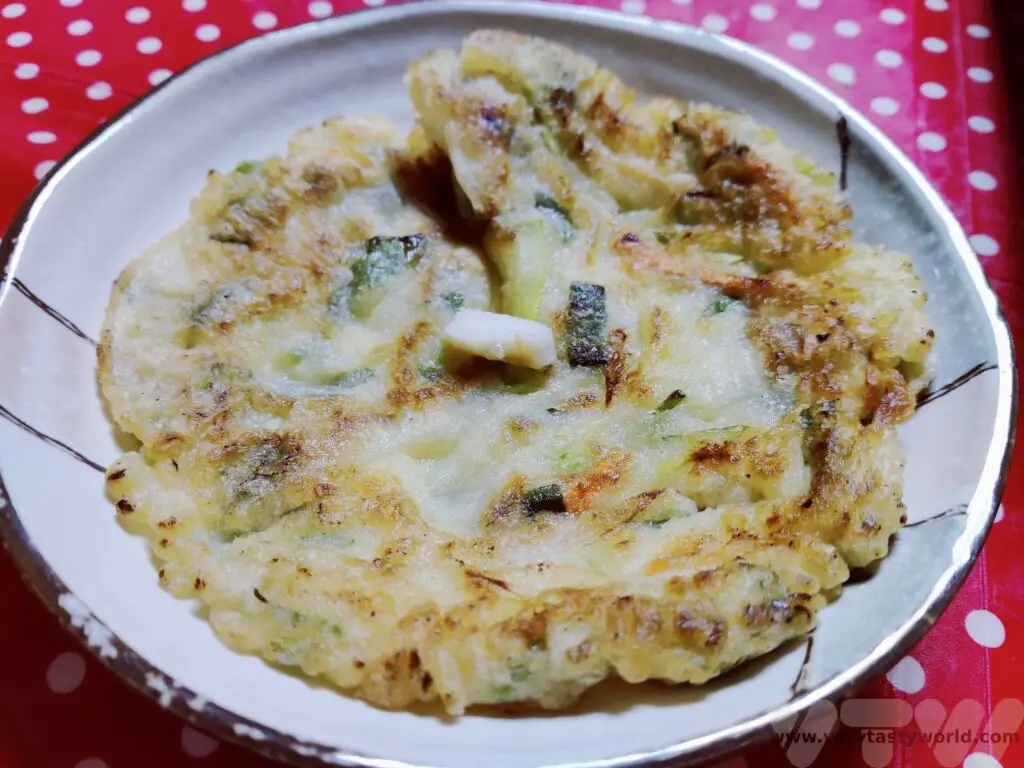
Eomuk – Fishcakes
Minced fish with vegetables and seasonings is another popular dish. These are available in shops/restaurants but are also widely available as street food.
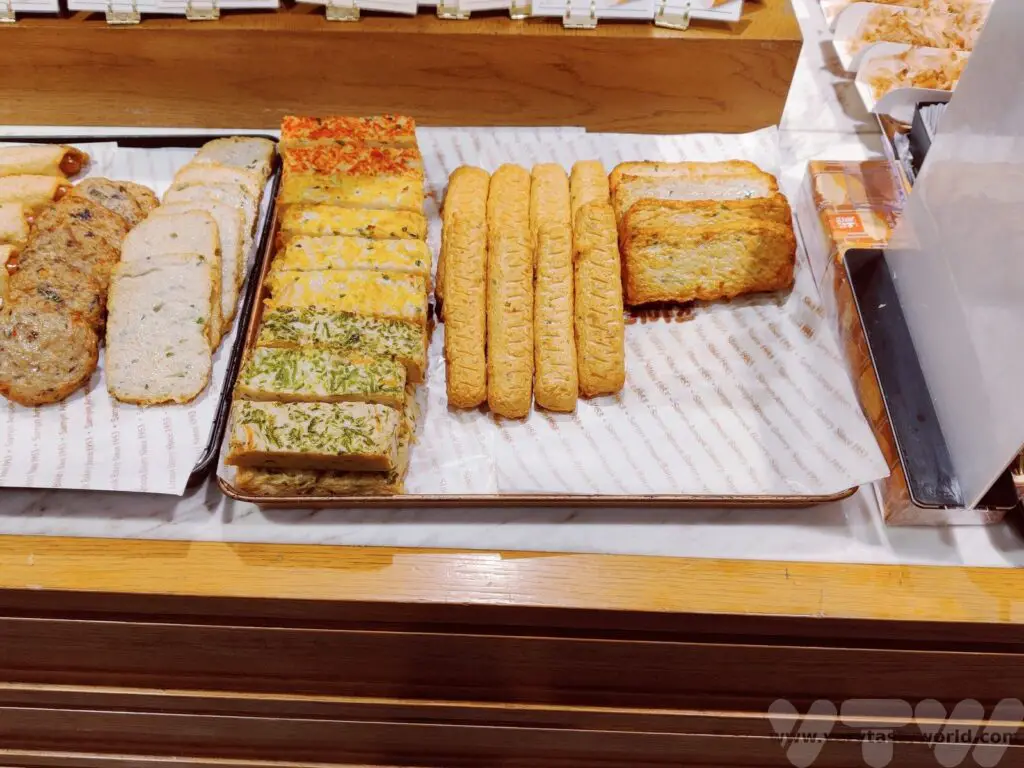
Dining At The Market
Both Seoul and Busan have large and extensive fish markets and it is possible not only to visit them but you can also eat incredibly fresh fish in the restaurants on the upper floors.
If you want, you can buy the fish in the market and then take it upstairs to be cooked to your liking. There will be a table charge (which may be reduced if you decide to order the restaurant’s fish stew) and a cooking charge.
In Busan, the Jalgachi market is the largest in South Korea and has multiple restaurants on the first floor, which all have the same menu. In Seoul some of the restaurants in the Noryangjin fish markets will help you – either by explaining the process, or by offering a picture menu where you can choose your fish/shellfish (they will give the market price) and they will go downstairs to buy the fish for you.
We enjoyed a plate of raw wild fish, sashimi style with eye-wateringly fiery wasabi. It was very different to the Japanese sashimi we have eaten in the past. It didn’t melt in the mouth but had a much firmer texture. The sashimi was accompanied by wonderfully sweet pan-fried rockfish, fresh crab and deliciously umami fish stews.
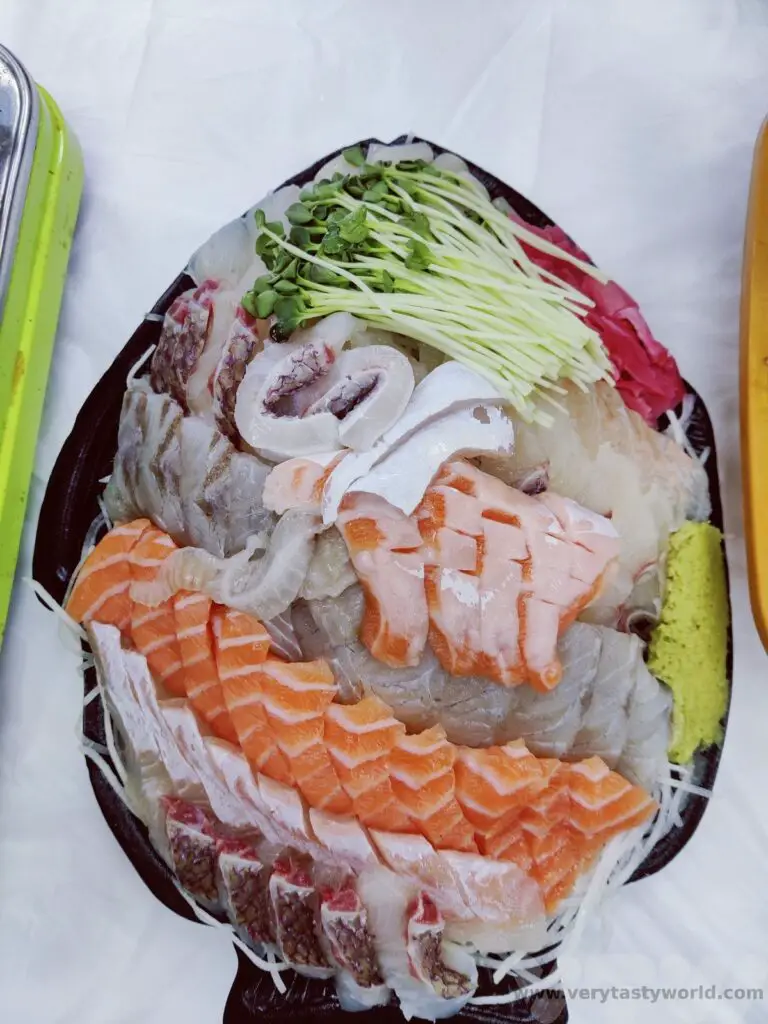
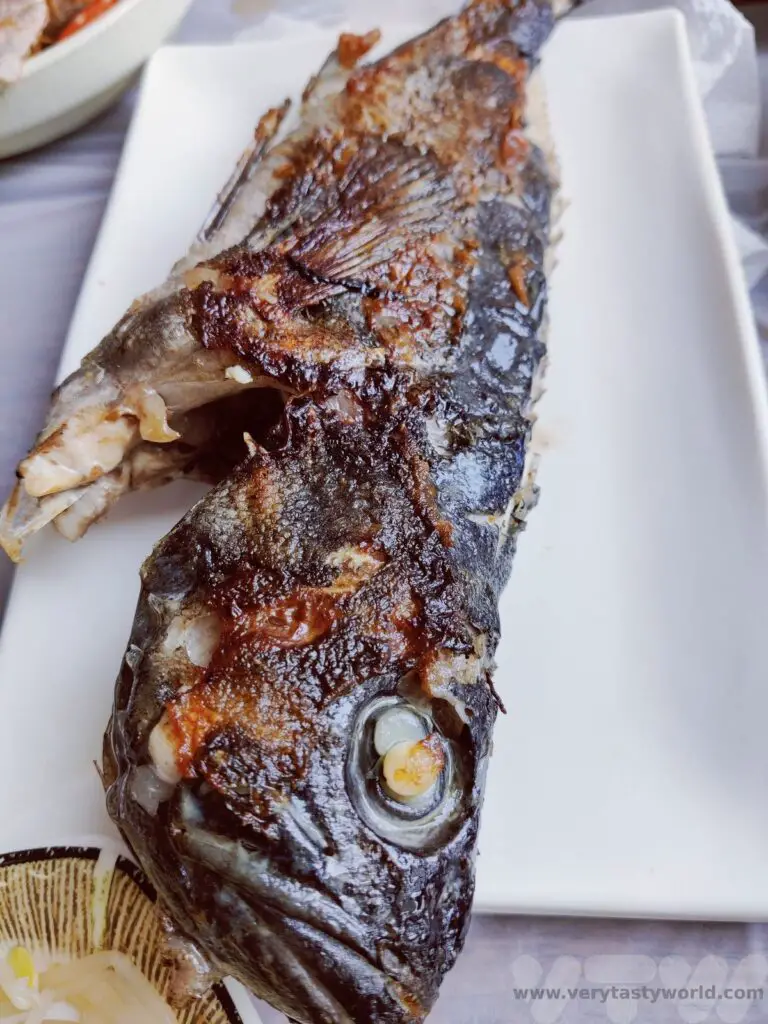
If you’re eating crab those amazing Korean scissors come into play – they will easily cut through the hard shell then you can use a chopstick to pick out the sweet and succulent crabmeat.
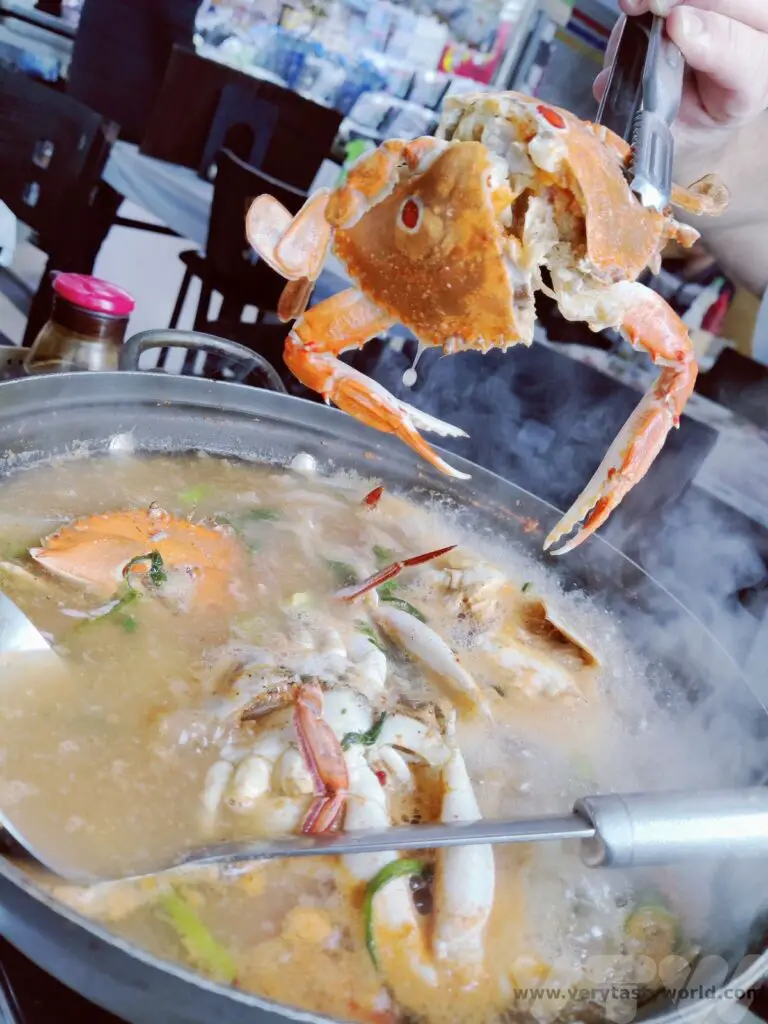
Street Food
The very first Korean food we tried was at a local market which we had decided to explore just as we had arrived in the afternoon in Seoul. Feeling tired and slightly woozy after a 16 hour journey, we sauntered up to a market stall and bought a fishcake for a mere 1000 won (less than $1). This undulating slice of fishy goodness woven along a wooden stick and served in a cup with a generous splash of stock was sublime – warming and packed with umami. We were instantly sold on street food.
We decided to have breakfast at Seomun market in Daegu one day. There was a wide variety of food on offer. Some of the fishcakes keep warm in a broth – watch out for the red-tipped sticks as those will be the spicy ones!
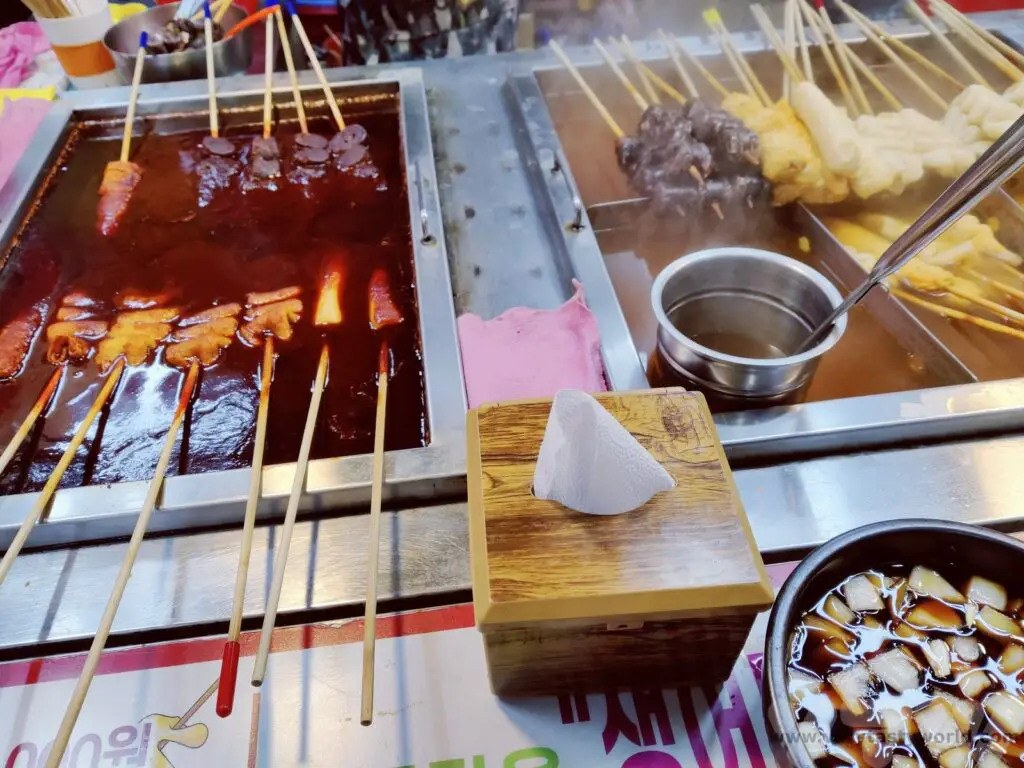
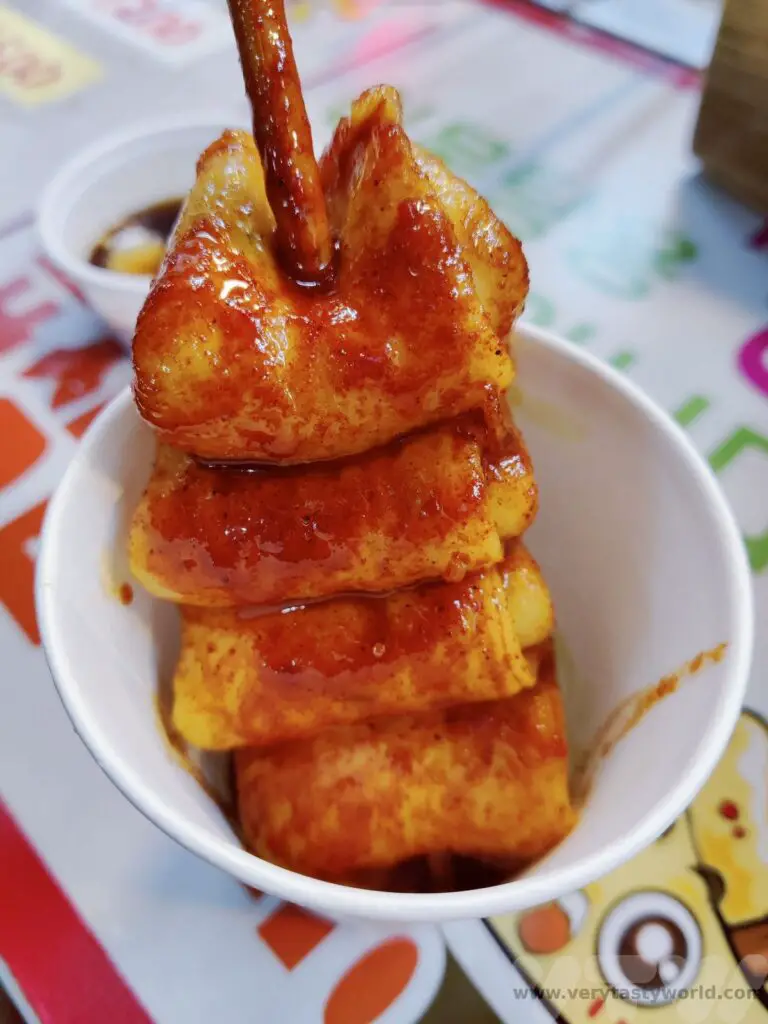
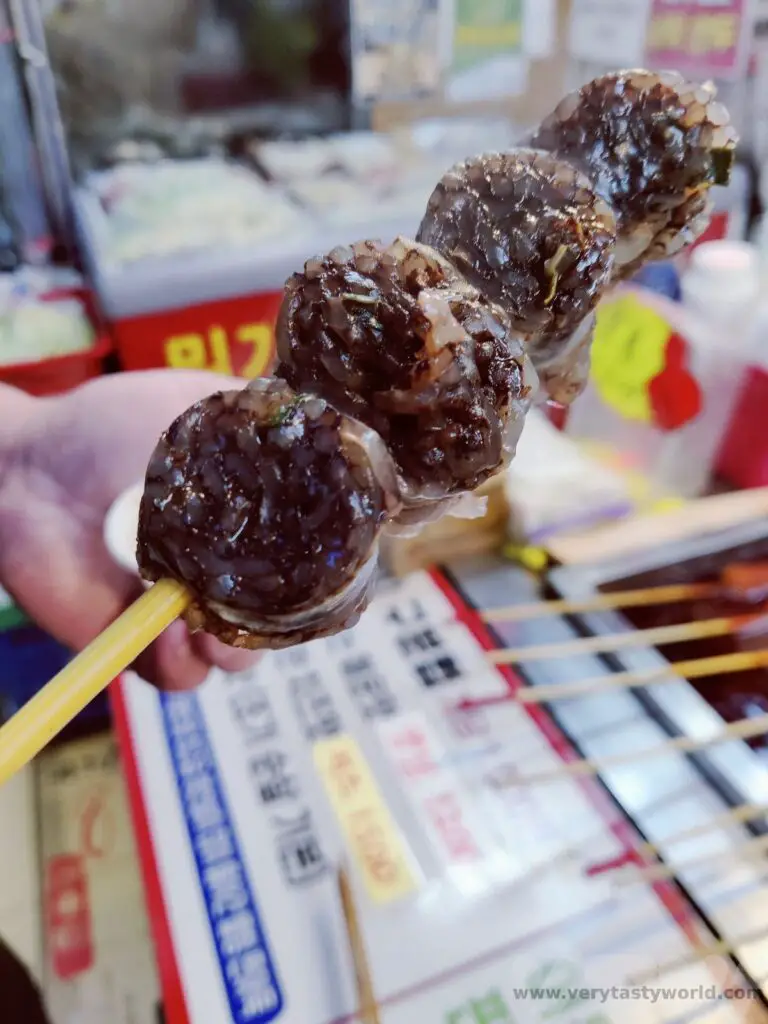
Hotteok (sounds a bit like hot-dog) is a fluffy fried doughnut filled with seeds and nuts.
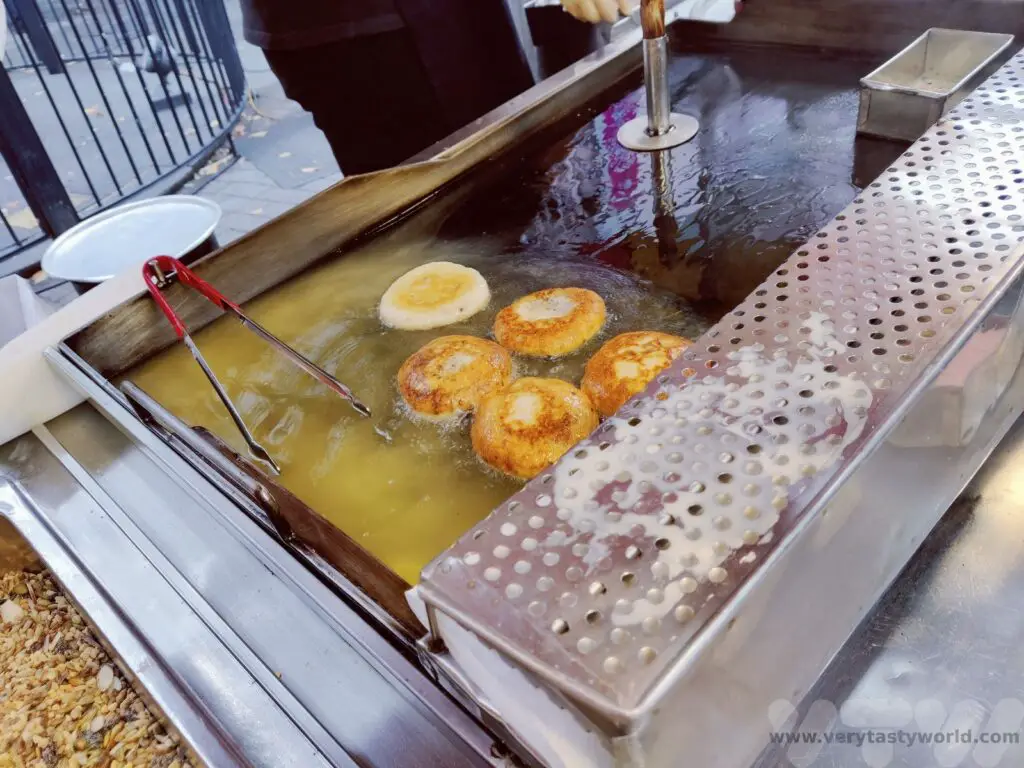
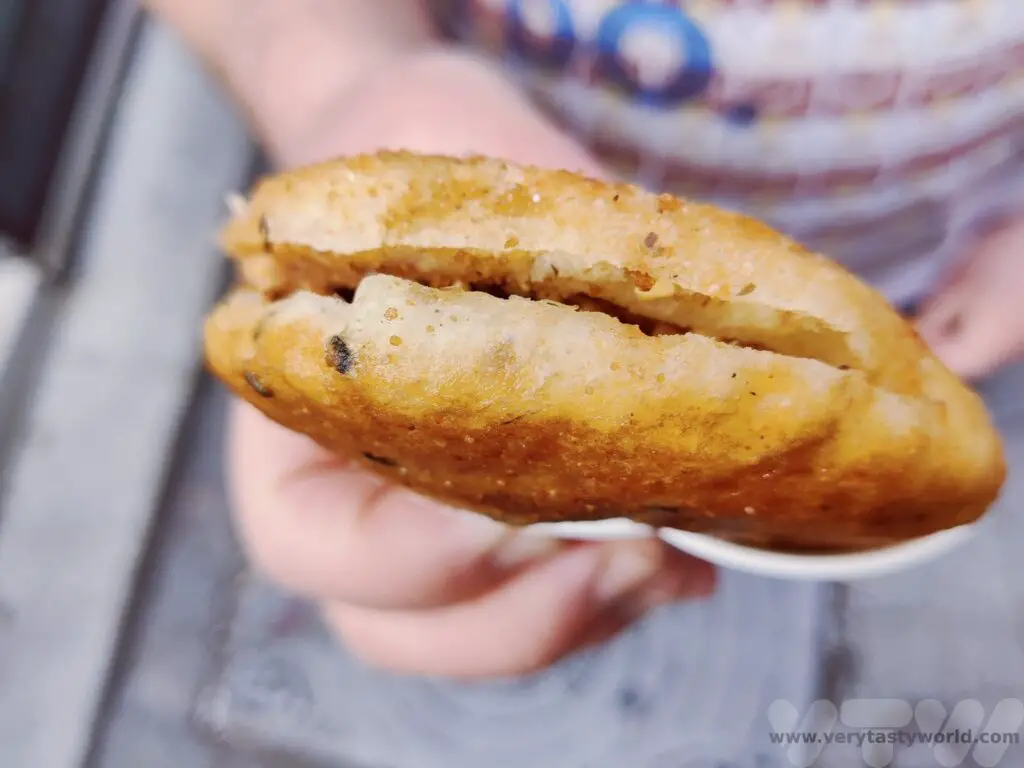
Many market stalls make pancakes fresh to order.
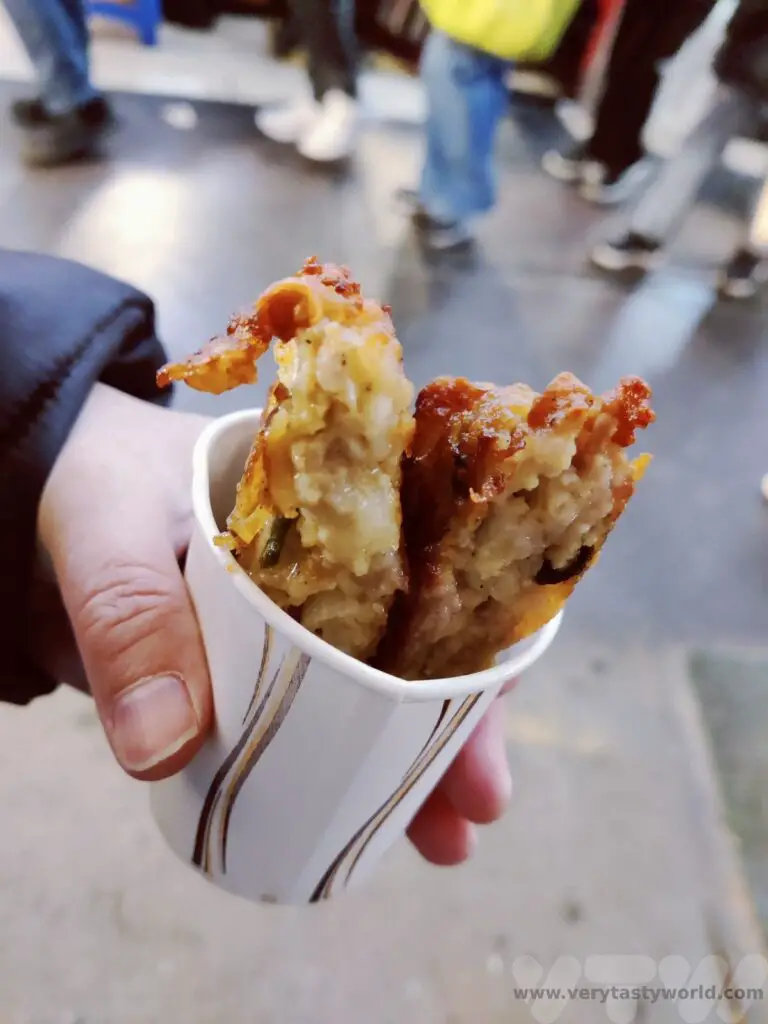
Most street food is served in paper cups.
Vegetarians/Vegans
It is not impossible to dine well if you are vegetarian or vegan. We did spot some vegan restaurants in many of the cities we visited. Veggie options will be available – e.g. tofu stews – but you might have to be careful that the base stock is vegetable based as some of these may use fish.
A menu that did make us laugh a little was a dumpling restaurant in Gyeongju. The proprietor was absolutely delightful and made awesome dumplings, plump and filling, in a variety of styles. But the menu was admirably honest about the fact that there was pork in all the savoury dumplings. Which is actually reassuring.
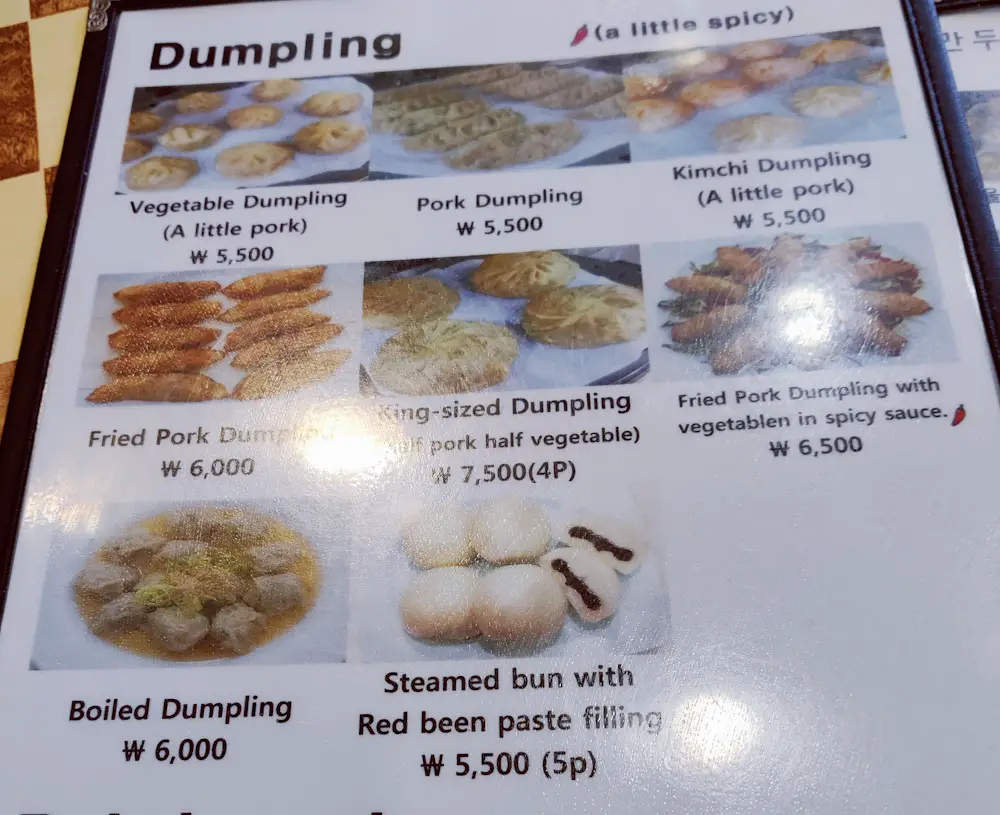
Some Useful Phrases
| Please give me | 주세요 | joo-say-yo | Say at the end of the sentence after the thing you want. e.g. banchan joo-say-yo |
| Excuse me YOU – over here | – 저기요 | juh-gee-oh | To get attention |
| People | 세명 | doo myung | 2 people. If you want a table for 2, it’s fine to just indicate with your fingers |
| Bottle | 맥주 여섯 병 | maek-ju doo byung | maek-ju (beer) doo byung (2 bottles) |
| 1 more bottle of soju please | 소주 두병 더 주세요 | so-ju hana-byung duh joo-say-yo | |
| More | 더 | Duh | |
| Please give me more kimchi | 김치 더 주세요 | kimchi duh joo-say-yo | |
| This please (pointing) | 이거 주세요 | Ee-guh joo-say-yo | |
| Delicious | 맛있어요 | mah-shis-say-yo | Saying this was guaranteed to raise a smile at the end of our meals! |
| NUMBER | KOREAN | Korean pronunciation |
| One | 하나 | hana |
| Two | 둘 | dool |
| Three | 셋 | sayt |
| Four | 더섯 | nayt |
| Five | 더섯 | duh-suht |
| Six | 여섯 | yuh-suht |
| Seven | 일곱 | ill-gope |
| Eight | 여덜 | yuh-duhl |
| Nine | 아홉 | ah-hope |
| Ten | 열 | yuhl |
| Eleven | 열하나 | yuhl-hana |
A Cookery Class
A fun way to spend an afternoon in Seoul or Busan is to join a cookery class. With a small group of fellow travellers these classes usually involve a visit to a local market to learn about the amazing produce on sale – from the familiar to some enticingly unusual foods.
Then you’ll go on to visit your host’s home to cook several delicious dishes. We made pajeon – and had great fun flipping the pancakes. Bibimbap and dakgalgi (a spicy chicken dish) were also on the menu.
Related Posts You May Enjoy

Thanks so much for reading. We hope you enjoyed this article. If you’d like to keep up to date with new posts and recipes, please subscribe to our newsletter or follow us on social media – X, Facebook or Instagram. We always love hearing from you and would be delighted to read your thoughts about this article.

RECIPE: How To Make Kimchi
Kimchi is a fundamental part of society in Korea. It is Korea’s national dish and is usually eaten with most meals there. In fact, kimchi making has been assigned as a UNESCO cultural heritage and even has its own day – 22nd November. Kimchi is great fun to make and we have a recipe for how to make kimchi. It isn’t a traditional Korean style but it’s easy to make, is ready very quickly and we reckon it’s much more delicious than shop-bought.
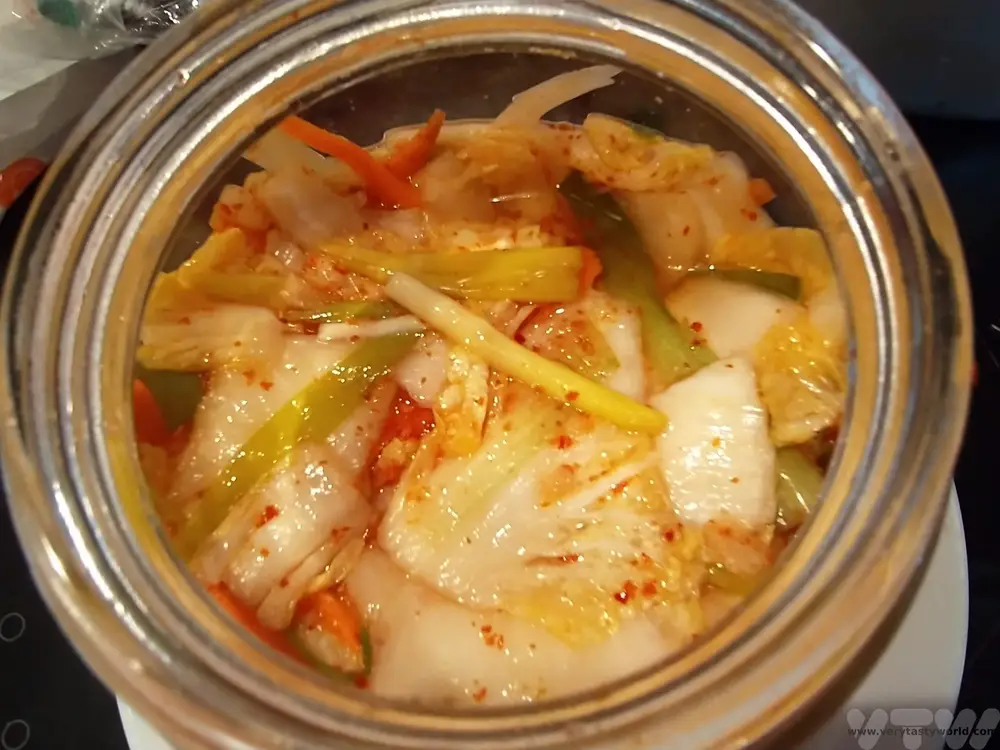
We first tried kimchi over 20 years ago and it was love at first bite – sour, spicy and crunchy, it has a unique flavour. Being a fermented food it is also purported to have properties that are beneficial for your gut health but, far more importantly, it’s delicious.
It’s surprisingly easy to make but it does take a while to ferment and you do have to watch out for potential explosions but that is what makes it so exciting! (Don’t worry, we’ve been making it for years and have never had an explosion – we have some advice on the best equipment to use at the end of this post.) We have tried fermenting lots different foods over the years, including miso, and it’s a very satisfactory process.
Kimchi is made via a lacto fermentation process whereby good bacteria, known as lactic acid bacteria, convert the sugars in vegetables into lactic acid. The joy of fermentation is that it isn’t a precise art. You need a bit of patience while the bacteria do their thing but once fermentation is complete, the finished product will last for many months, if not years – that is, if you don’t eat it straight away!
Ingredients For Making Kimchi
1 Chinese leaf cabbage (also known as Napa cabbage)
1 carrot
2 spring onions (green onions)
A carrot’s length of daikon white radish, also known as mooli (optional)
2 fat cloves of garlic (3 if your garlic isn’t portly enough)
1 tbs fish sauce (vegetarians can use soy sauce, but use less – 1/2 tbs)
1 thumb-sized piece of ginger
1 tbs Korean chilli red pepper powder known as Gochugaru (you should be able to find this in Asian stores and even supermarkets these days). A variation is to use Korean chilli paste, known as Gochujang. Gochujang is traditional but we prefer the chilli powder for this kimchi.
3 tbs salt. You want to use a salt that doesn’t have anti-caking additives. Table salt isn’t recommended. Equally you don’t really want to use really posh salt. We tend to use Himalayan pink salt.
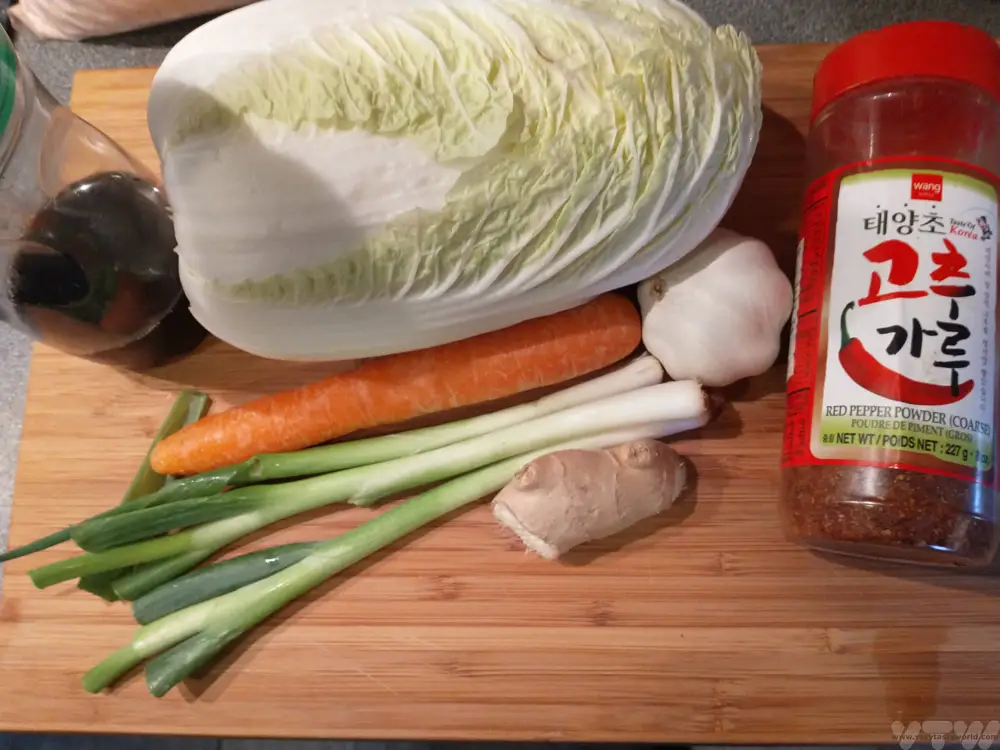
How To Make Kimchi: Method
Slice the cabbage into chunks. You want to have easily pick-upable bite-sized pieces. One of the nice things about the Chinese leaf is that it has a lovely broad ribs which retain their crunch when the kimchi is finished which makes a nice contrast with the softer leaves.
Place cabbage into a bowl and sprinkle with the salt. Massage the salt into the cabbage and wait a couple of hours. It is a lot of salt but you will be washing it through later.
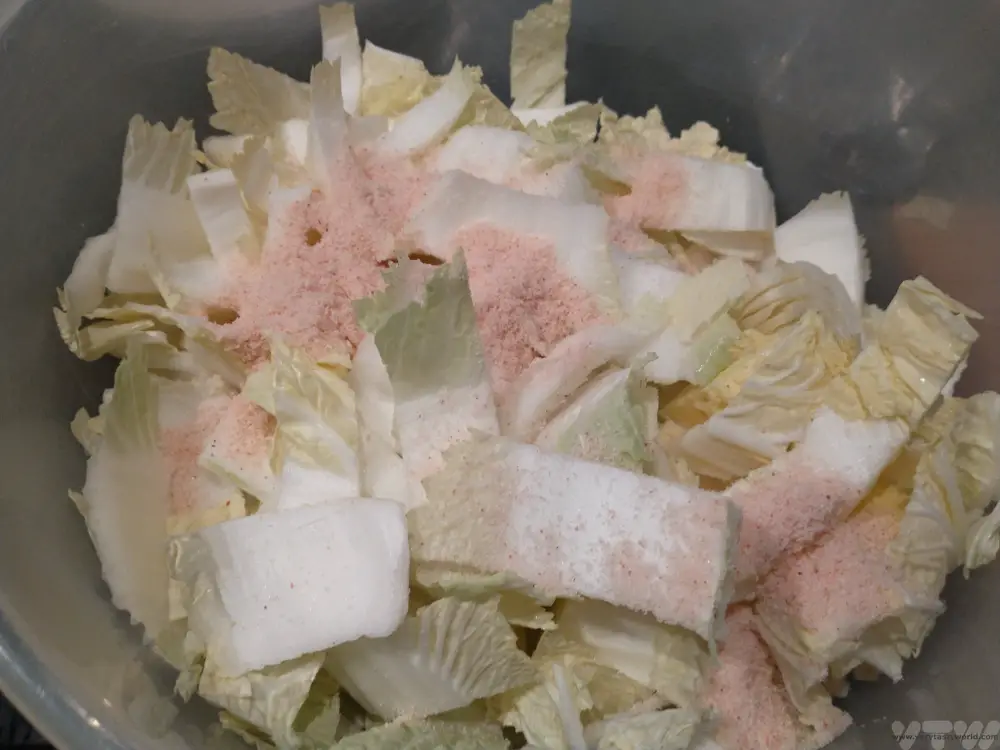
Prepare your fermentation jar. The size of the jar is important. You want to fill the jar up as much as possible and not have too much headspace. The jar size that suited our cabbage was 1.4 litre capacity. We recommend clip top Kilner jars as they have a good seal to keep air out but also let the liquid escape. There are some types of jar specifically designed for fermentation. We’ve had greater success with some than others.
The jar needs to be clean. We find the best way to clean the jar is to wash it in warm, soapy water and rinse. Then we boil a kettle and fill the jar (not forgetting the lid) with boiling water. After 10 minutes, drain and let the jar cool down. Some people put the jar into the oven on a low heat for 20 minutes but we haven’t found this step to be necessary for this type of fermentation.
After some time has passed, give the cabbage a quick rinse with water. Have a taste – it should taste salty but not overpoweringly salty. You don’t need to pat the cabbage dry.
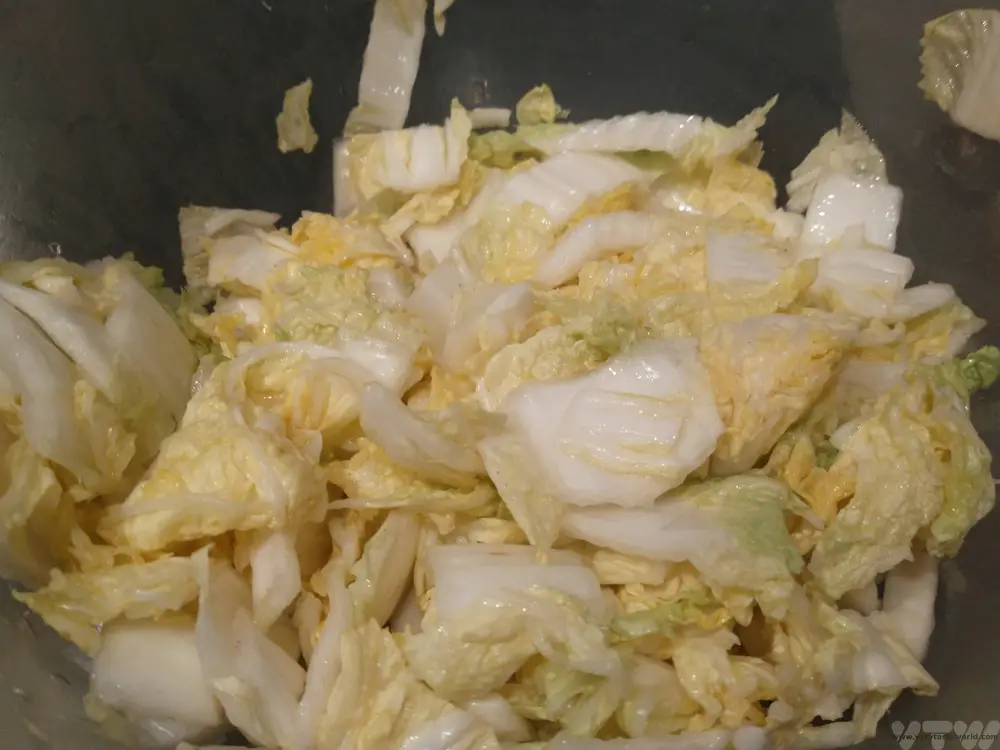
Julienne the carrot and daikon, if you are using it, slice the spring onions lengthways.
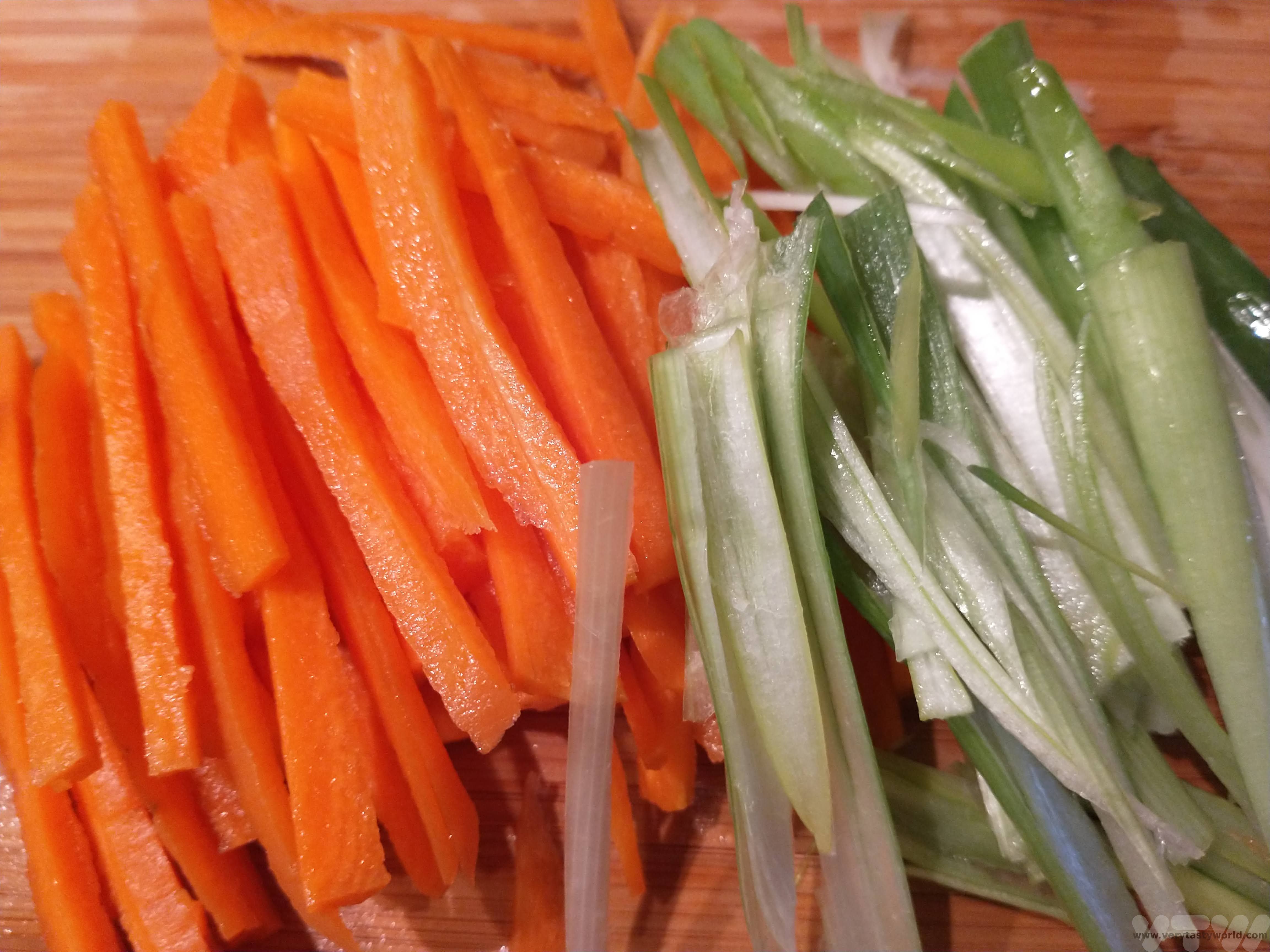
Put the garlic, ginger and fish sauce into a pestle and mortar and grind them together to create a paste. It will have quite a liquid consistency.
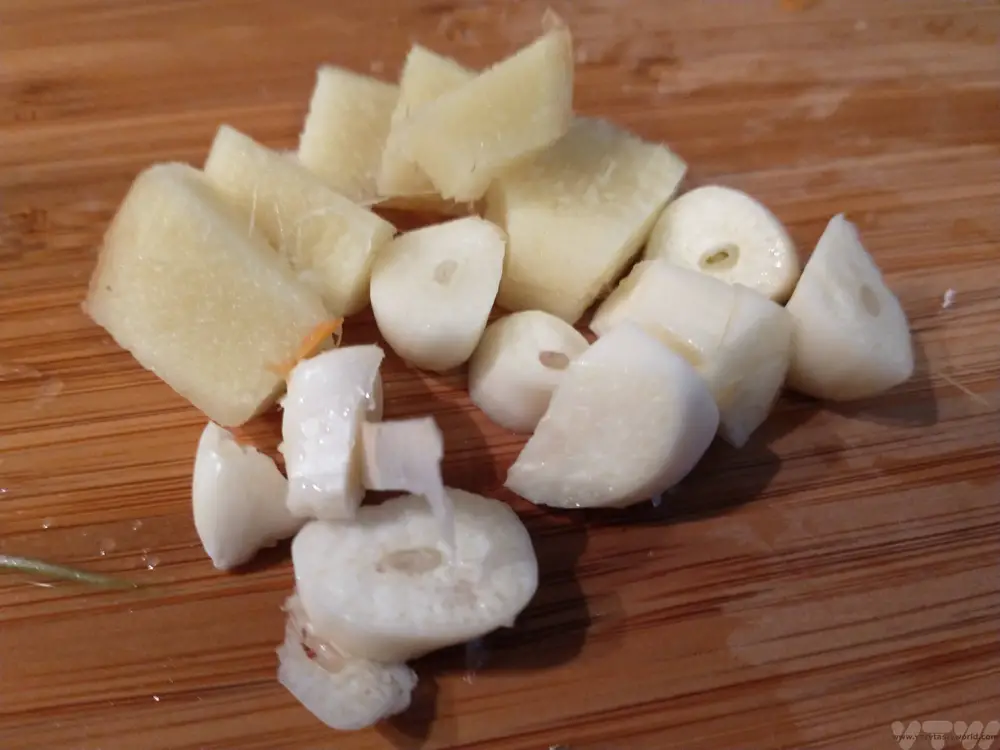
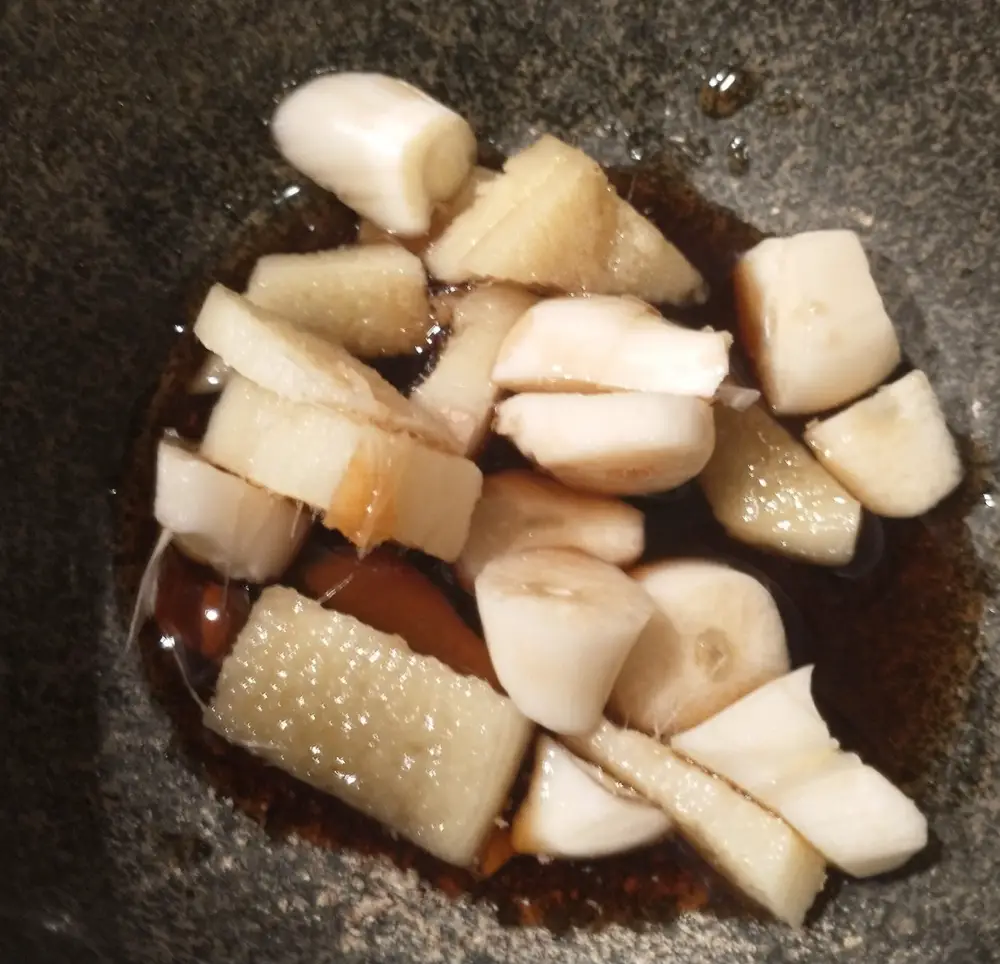
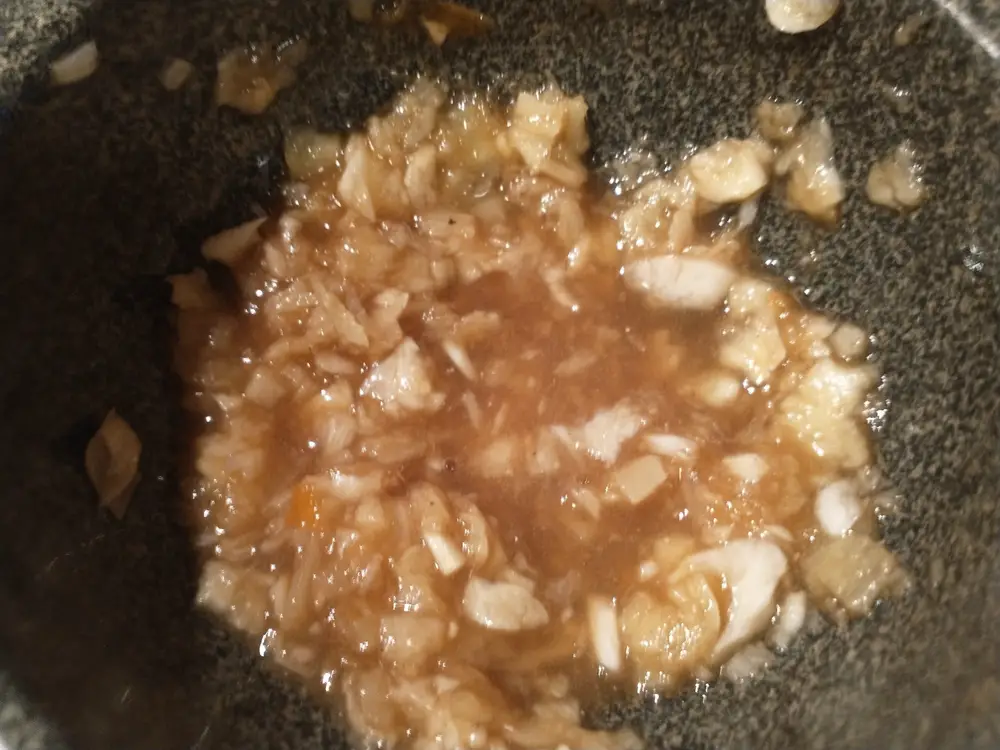
Add the vegetables to the cabbage.
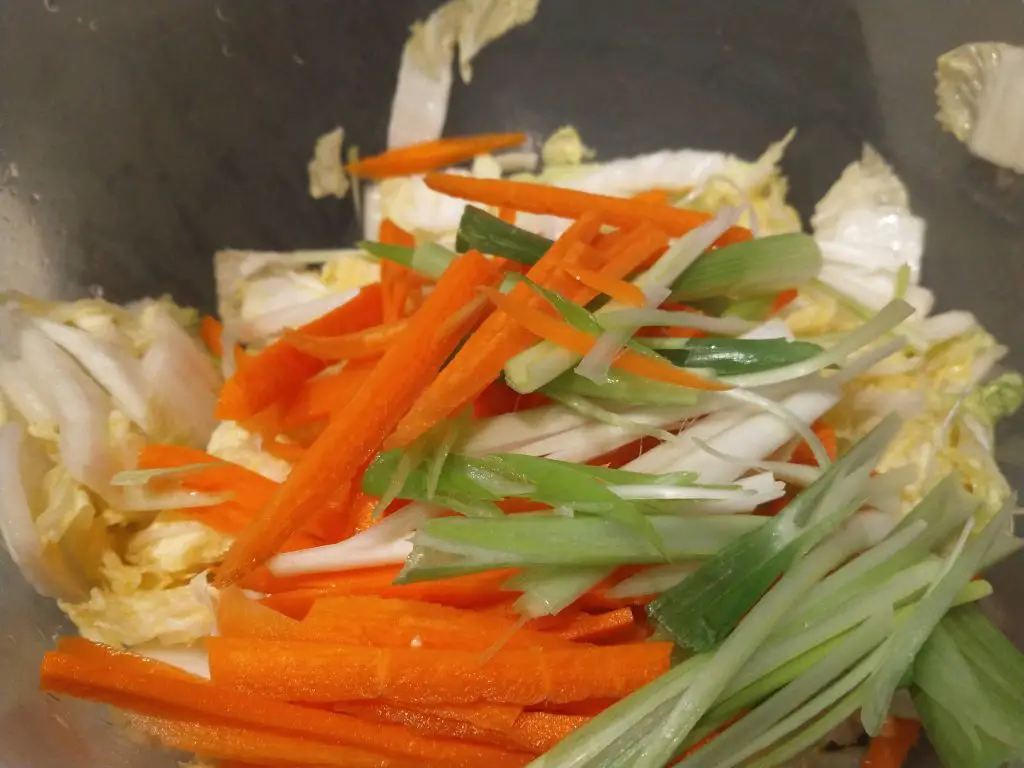
Pour over the garlic-ginger-fish sauce paste and sprinkle the chilli powder over the cabbage and veg. Mix well. We find it’s easiest to do this with our bare (clean) hands.
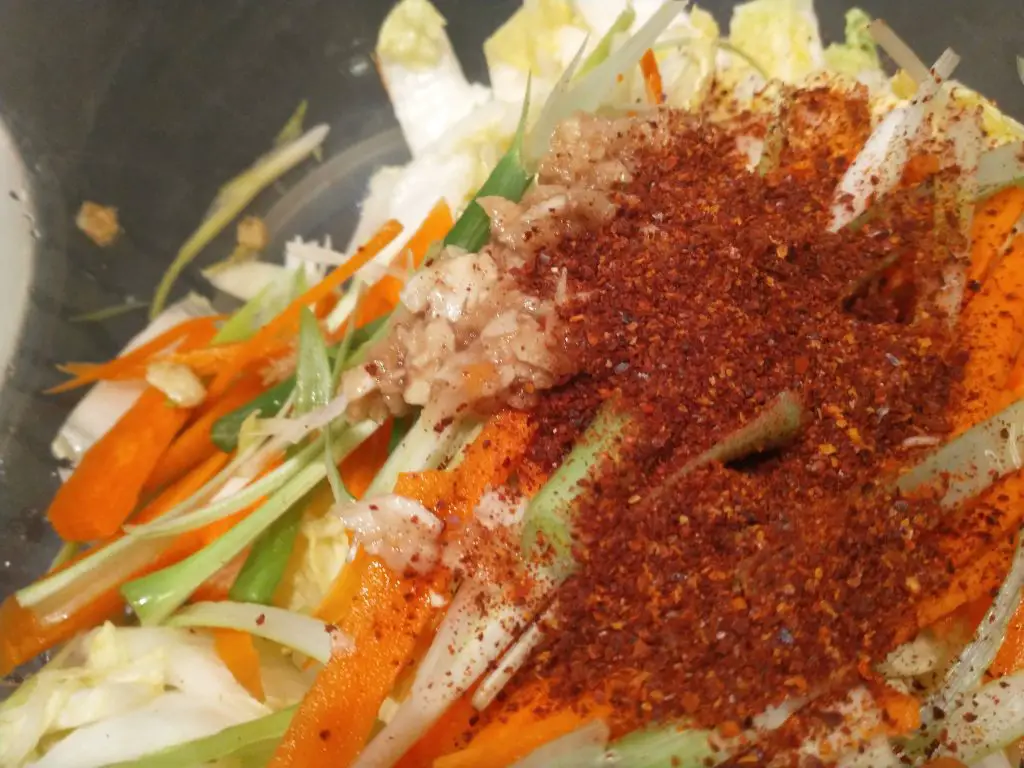
Then you need to pack the jar. Pick up handfuls of the cabbage mix and place into the jar, pushing down to squish it in – really pressing hard to make sure there aren’t any air gaps.
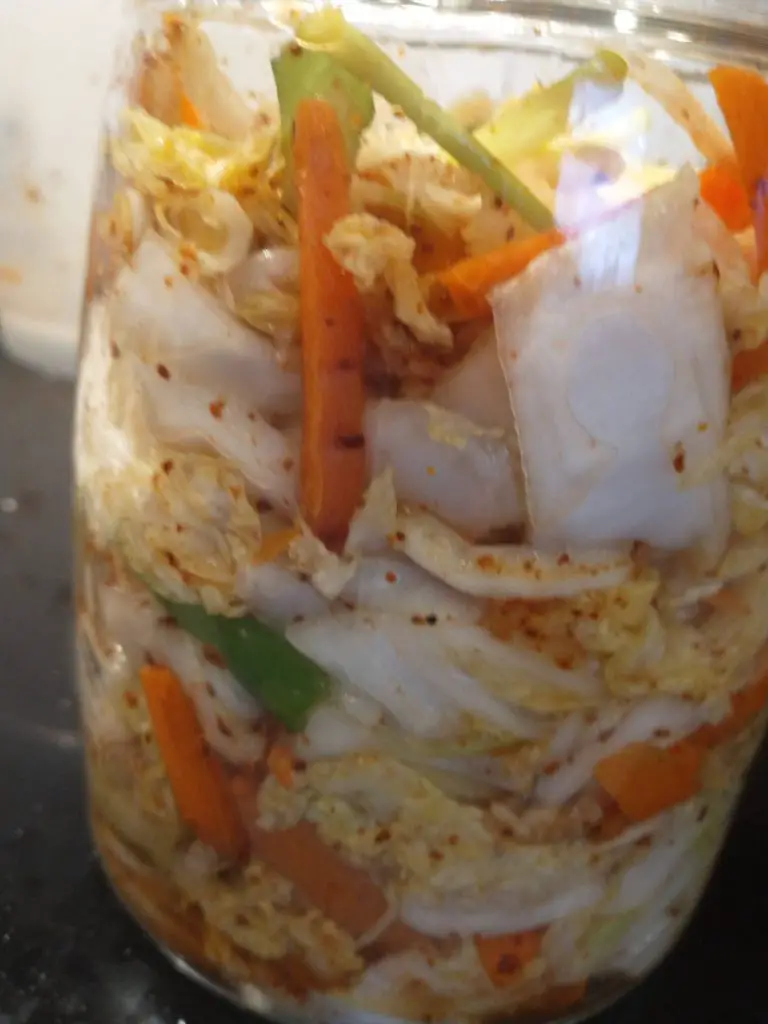
You should try and aim for minimum headroom at the top of the jar to reduce the air space. You also want to make sure the cabbage mixture remains pressed down. You can get all sorts of weights but a glass dessert ramekin type container (e.g. Gu) works well or, cheaper and less calorific than eating a chocolate dessert, fill a small plastic bag with water, tie at the end and squish into the top of the jar.
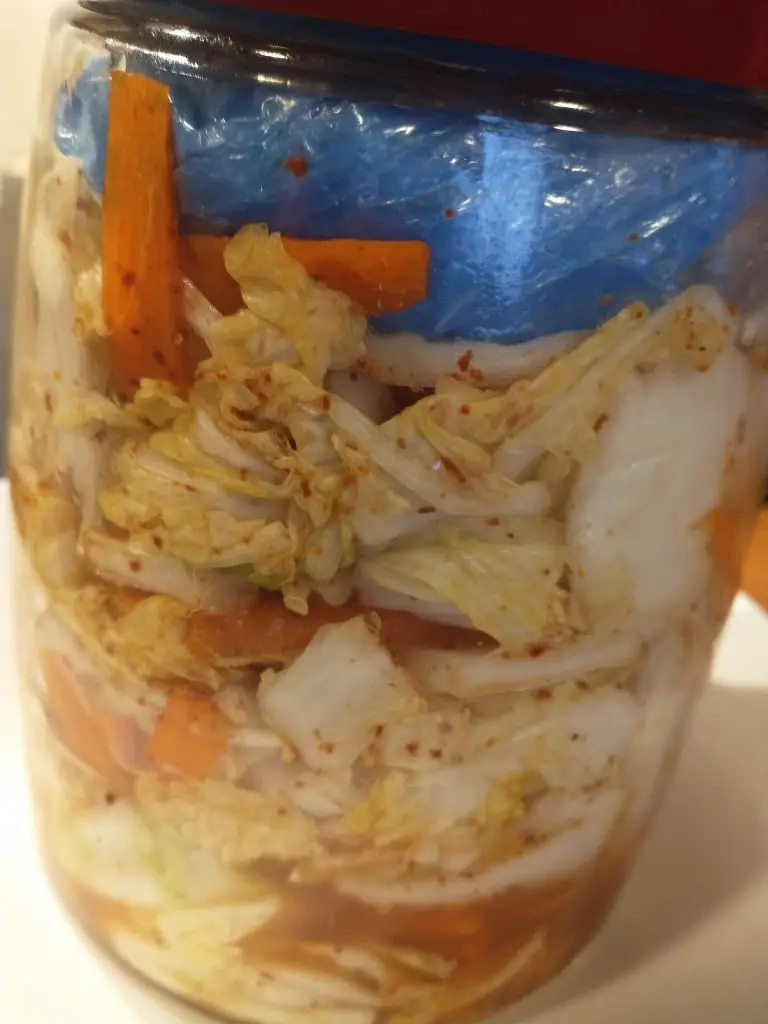
Close the jar and place the jar on a deep plate or in a bowl to catch any liquid escaping.
Check The Ferment Over Several Days
Over the next few days the cabbage will begin to ferment. The time it takes will depend on how warm the ambient temperature is. You’ll see a liquid start to form in the jar and cover the cabbage and the lactic acid bacteria will start to form lactic acid and C02. It is because of the C02 that you need to keep an eye on your ferment. If you are using a specific fermentation jar you should be fine. If you are using a conventional jar you will need to ‘burp’ your ferment, at least once a day. Open the lid – very briefly – and close immediately, just to let the C02 out. This will ensure that the pressure doesn’t build up. If you don’t burp there is a risk of the jar exploding. We’ve never had a glass jar break but there have been numerous occasions when I’ve burped the jar and ended up with a brine shower!
The kimchi should be ready within a week to 10 days. You can leave it longer if you wish and this will ensure further development of the flavours.

When the kimchi is ready you can store the jar in the fridge or decant it into smaller jars (just go through the process of cleaning them, then adding boiling water and letting them dry). The kimchi will store in the fridge for months as long as it is airtight.
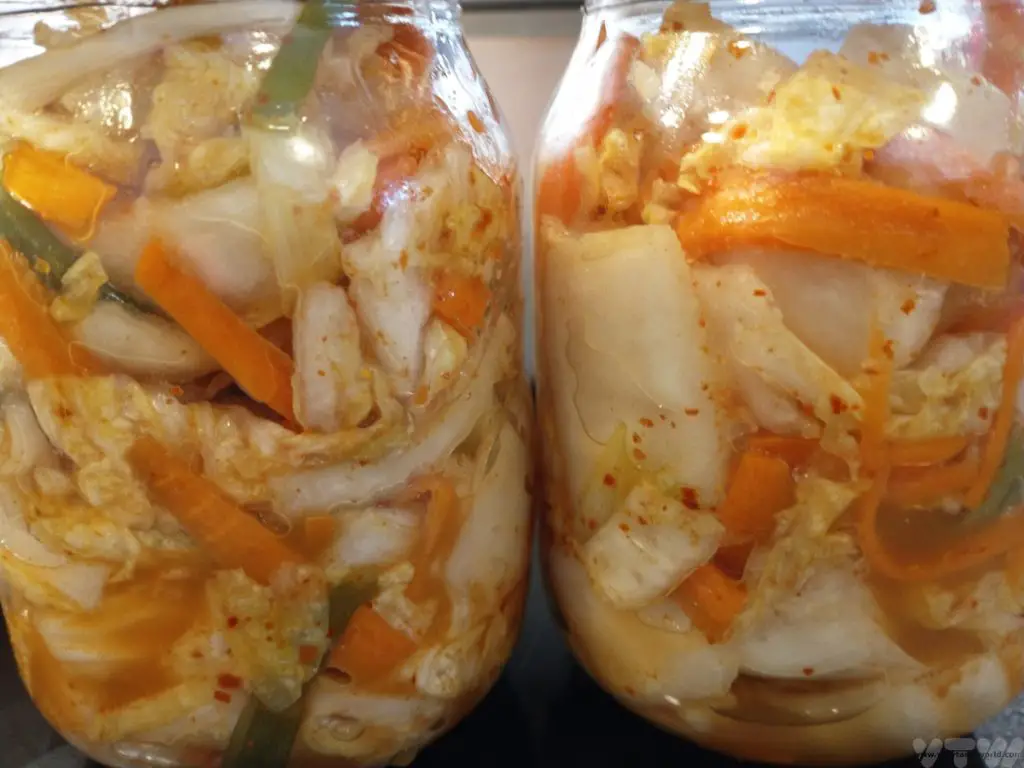
Beware
The two greatest issues with fermenting food is risk of explosion (which can be reduced/eliminated if you use the right equipment) and mould. When the ferment is exposed to air there is the potential for mould to develop. If you open your jar and see fuzzy mould of any colour you should discard the ferment. It’s heart-breaking but the safest thing to do as the mould could make you very ill. (It’s not advisable to scrape off the mouldy bits – by the time the fuzz has appeared the spores will have permeated the whole jar.) Obviously this creates something of a dilemma – you need to open the jar to burp but don’t want to let the air in. So, the key is to open the jar very quickly to release pressure then close immediately. With some types of fermentation jar you don’t need to worry.
Some Notes On Fermentation Equipment
You don’t need too much specialist equipment to ferment food. A kilner jar with a metal clip lid ‘self-burps’ – it allows CO2 to escape whilst not letting air (which can contain mould spores) in. You can get various fermentation vessels in varying sizes.
Salt should not have anti-caking properties.
You can get chilli flakes or gochujang in Asian supermarkets.

- RECIPE Oyakodon Donburi
- Zero Waste Recipes Before Your Holiday
- RECIPE: Vegetable Biryani Tamil Nadu Style
- RECIPE: Vegan Wild Garlic Pesto
- Recipe: Venetian Pasta Sauce
- RECIPE: Biryani Raita Recipe
- RECIPE: How to Make Costa Rica’s Gallo Pinto
- Recipe: Japanese Simmered Pork Belly – Buta no Kakuni
- RECIPE: How to Make Umeboshi
Please note that this post contains affiliate links. If you click the link and decide to make a purchase we will earn a small commission, at no cost to you, which helps towards running this site.
